Sites: news | india | latam | brasil | indonesia
Feeds: news | india | latam | brasil | indonesia
topic: Snakes
Social media activity version | Lean version
Small, secretive & highly venomous snake seen for first time in Nepal’s hills
- In July 2022, a lesser black krait (Bungarus lividus), a small, secretive and highly venomous snake, was discovered in Dhankuta, Nepal’s eastern hills.
- The snake, previously documented only in Nepal’s plains, was identified by veteran herpetologist Karan Bahadur Shah.
- A study documenting the findings highlights the need for urgent measures, including the establishment of antivenom quick-treatment centers in local hospitals, raising awareness through campaign, and addressing potential human-snake conflicts in the wake of this discovery.
Photos: Top species discoveries from 2023
- Scientists described a slew of new species this past year, including an electric blue tarantula, two pygmy squid, a silent frog, and some thumb-sized chameleons.
- Experts estimate less than 20% of Earth’s species have been documented by Western science.
- Although a species may be new to science, it may already be well known to local and Indigenous people and have a common name.
- Many new species of plants, fungi, and animals are assessed as Vulnerable or Critically Endangered with extinction as soon as they are found, and many species may go extinct before they are named, experts say.
For Vietnam’s rare reptiles, lack of captive populations may spell doom
- As an epicenter of biodiversity, Vietnam hosts a wide array of reptile species. But new research shows that many species that occur nowhere else on the planet are poorly known and lacking protection.
- The researchers also found that many of Vietnam’s rarest species are absent from the world’s zoo collections and conservation breeding programs, risking their disappearance forever should their wild populations collapse.
- They call on conservationists and authorities to focus on conservation measures to protect the country’s most vulnerable reptiles, including establishing assurance populations that could be used in the future to repopulate areas of wild habitat from which they have been lost.
It had to be a snake: New species from Peru named after Harrison Ford
- Scientists have described a new-to-science snake species from Peru’s Otishi National Park and named it after the actor Harrison Ford for his conservation advocacy.
- The pale yellowish-brown snake with black blotches was found in high-elevation wetlands and identified using genetic techniques.
- The team faced risks from illegal drug activity in the remote park area where the snake was found, cutting their survey short.
- Satellite data and imagery show several areas of forest loss throughout the park, which appear to have been caused by natural landslides. Still, some bear the hallmarks of human-caused clearing likely linked to coca cultivation and drug trafficking.
‘What we need to protect and why’: 20-year Amazon research hints at fate of tropics
- In its bold outlines, many informed people understand that climate change is reducing tropical biodiversity and thereby degrading the functionality and ecoservices of tropical forests. But what are the specific mechanisms by which these forests are being diminished over long time frames?
- One project on the slopes of the Peruvian Amazon has tried to make exactly that type of assessment, via a 20-year ongoing research project that meticulously observes a narrow transect of rainforest stretching from the Amazon lowlands near sea level to the Andean highlands above 3,352 meters (11,000 feet).
- The international team conducting this work, the Andes Biodiversity and Ecosystem Research Group (ABERG), is painstakingly observing changes in more than 1,000 tree species, birds, frogs, snakes and more to determine not only how much climate change is affecting them, but untangling how the change process works.
- This type of in-depth research is vital to conserving tropical rainforest diversity, the carbon storage capacity it offers, and its assistance in maintaining long-persisting regional and global precipitation patterns vital to agriculture and other water needs. Mongabay contributor Justin Catanoso traveled to Peru to observe ABERG at work.
Rattlesnakes can calm down their friends, study shows
- Research reveals that rattlesnakes, like humans, experience stress reduction when in the presence of a companion snake, a phenomenon known as social buffering.
- Stress can lead to hormonal changes, affecting the nervous system, immune response and behavior.
- The study examined 25 wild Southern Pacific rattlesnakes in different scenarios, measuring their heart rate to assess stress levels and social buffering.
- By controlling small mammal populations, rattlesnakes maintain ecosystem balance and also reduce rodent and tick-borne diseases. Yet, they often face threats from humans.
Resurgence of deadly Russell’s viper prompts Bangladesh to develop antivenom
- Reports of bites from Russell’s viper, the deadliest snake on the Indian subcontinent, have increased in Bangladesh since 2013.
- At least 20 deaths were recorded from 17 of Bangladesh’s 64 districts between 2013 and 2016, all attributed to Russell’s vipers.
- Researchers attribute this to improvements in farming intensification, which means rats — the snake’s prey of choice — are present in crop fields year-round, whereas before they were only there for part of the year.
- Snakebites are a significant cause of illness and mortality in Bangladesh, with an estimated 6,041 deaths annually, but Bangladesh still relies on imported antivenom — although a newly established Venom Research Centre aims to address this shortcoming and boost research on the country’s venomous snakes.
Red coral kukri sightings in Bangladesh prompt call to save rare snake habitat
- The red coral kukri (Oligodon kheriensis) is endemic to a small region of the Himalayan tracts of northern India and Nepal; the snake species was first spotted in Uttar Pradesh in India in 1936.
- For the first time, the rare species was found in Bangladesh on Oct. 27, 2020, while locals were digging soil in a bamboo bush in Panchagarh district; this indicates an expansion of the snake’s distribution range.
- In northern Bangladesh, land use patterns have changed, making forests highly fragmented, indicating that habitat loss, forest degradation and fragmentation are major threats to the species.
- Experts suggest taking immediate conservation measures in the areas where the red coral kukri is found by imposing specific measures to stop the destruction of bamboo bushes and forests.
Scientists make ‘rare’ new identification of snake family: Micrelapidae
- A multinational team of researchers has identified a new family of snakes, Micrelapidae, which live in East Africa and the Middle East.
- These small, rear-fanged venomous snakes are thought to have diverged from the rest of the evolutionary tree 50 million years ago and since evolved separately as a distinct family.
- Kenyan researchers hope the news will aid efforts to raise awareness of snakes and their importance to the ecosystem, as it is common for people in Kenya to fear – and kill – snakes.
Newly described DiCaprio’s snake and others threatened by mining in Ecuador and Panama
- Researchers have described five new species of snail-eating snakes from the upper Amazon Rainforest in Ecuador and Colombia and the Chocó-Darién forests of Panama.
- Three of the new species were named by actor Leonardo DiCaprio, conservationist Brian Sheth, and the NGO Nature and Culture International to raise awareness about the threats these snakes face due to mining and deforestation.
- Ecuador and Colombia saw an increase in illegal gold mining along rivers and streams during the COVID-19 pandemic, which may have affected populations of these fragile snakes and has led to conflict and division within communities.
- Snail-eating snakes are arboreal and depend on wet environments to survive, so deforestation and mining pollution, including illegal gold mining, affect both the snakes and the snails and slugs that they rely on for food.
Top 15 species discoveries from 2022 (Photos)
- A resplendent rainbow fish, a frog that looks like chocolate, a Thai tarantula, an anemone that rides on a back of a hermit crab, and the world’s largest waterlily are among the new species named by science in 2022.
- Scientists estimate that only 10% of all the species on the planet have been described. Even among the most well-known group of animals, mammals, scientists think we have only found 80% of species.
- Unfortunately, many new species of plants, fungi, and animals are assessed as Vulnerable or Critically Endangered with extinction.
- Although a species may be new to science, it may already be well known to locals and have a common name. For instance, Indigenous people often know about species long before they are “discovered” by Western Science.
Nepal conservationists work to overturn ‘all snakes are venomous’ mindset
- Snake conservation in Nepal is hampered by both a lack of research and poor awareness among the public and the government about the country’s snake species.
- Only about 20 of the 70-odd snake species found in Nepal are venomous, but deaths from snakebites have fueled perceptions that most are dangerous.
- The government’s approach to the problem is to treat all snakebites as toxic, but conservationists say a better understanding of the snakes involved would be more effective.
- Organizations like the Nepal Toxinology Association use different media such as street plays, social media posts and videos to spread awareness about snake conservation in the country.
Study casts doubt on sustainability of regulated blood python snakeskin trade
- There’s no evidence to show that the trade in blood pythons from Indonesia, coveted for their skins for making luxury fashion items, is sustainable, a new study shows.
- In fact, the evidence indicates that much of the trade, which involves slaughtering and skinning the snakes by the tens of thousands every year, may be illegal.
- The species isn’t considered threatened or protected in Indonesia, the main producer of blood python skins, and exports are governed by CITES, the convention on the international wildlife trade.
- The study’s author calls on the Indonesian government to enforce stricter monitoring and scrutiny of annual harvests, traders to abide by the regulations, and global buyers to shift away from exotic leather and use alternatives.
Top 15 species discoveries from 2021 (Photos)
- Science has only just begun to find and describe all of the species on Earth; by some estimates, only 20% have been described.
- This year, Mongabay reported on newly described species from nearly every continent, including an Ecuadoran ant whose name broke the gender binary, an acrobatic North American skunk, an Australian “killer tobacco,” a fuzzy orange bat from West Africa, tiny screech owls from Brazil, and more.
- Though a species may be new to science, that doesn’t mean it has not yet been found and given a name by local and Indigenous communities.
New Himalayan snake found via Instagram
- Locked down at home during the pandemic last year, a postgraduate student in India’s Himalayan region photographed a snake in his backyard that experts had never before seen.
- Uploaded to Instagram, the picture caught the attention of a herpetologist in another part of the country, who set out to find out more about the snake.
- In a newly published paper, they describe it as a new-to-science species of kukri snake (Oligodon spp.).
- The authors say the discovery points to the hidden wealth of biodiversity in the western Himalayas, and call for more studies in this region.
For sea snakes, underwater sex is a washout more often than not
- A sea snake’s senses of sight and smell are greatly diminished underwater, and the added challenge of trying to stay buoyant makes underwater mating no easy feat.
- A new study has identified several distinct features unique to adult male turtelheaded sea snakes thought to help improve their chances of coupling with a female underwater, most notably a high concentration of touch receptors in key spots along the body.
- A previous study found 20 of 31 male turtleheaded snakes lost contact with the female during courtship, often then attempting to mate with nearby objects such as a diver’s fin or sea cucumber.
Reptile traffickers trawl scientific literature, target newly described species
- The descriptions and locations of new reptile species featured in scientific literature are frequently being used by traders to quickly hunt down, capture and sell these animals, allowing them to be monetized for handsome profits and threatening biodiversity.
- New reptile species are highly valued by collectors due to their novelty, and often appear on trade websites and at trade fairs within months after their first description in scientific journals.
- In the past 20 years, the Internet, combined with the ease and affordability of global travel, have made the problem of reptile trafficking rampant. Some taxonomists now call for restricted access to location information for the most in demand taxa such as geckos, turtles and pythons.
- Once a new species has been given CITES protection (typically a lengthy process), traders often keep the reptiles in “legal” commercial circulation by making false claims of “captive breeding” in order to launder wild-caught animals.
Deadly new snake named after mythical Chinese goddess of healing
- Researchers have described a new species of venomous snake, from one of the deadliest and most medically significant groups of snakes in Asia.
- The Suzhen’s krait is found in rice fields and streams in monsoon forests in southwestern China and northern Myanmar.
- Understanding the differences between lethal snakes provides essential information for antivenin development and proper snakebite treatment, the authors say.
- The researchers chose to name the snake after Bai Su Zhen, a snake goddess from the popular traditional Chinese myth Legend of White Snake, “in honor of her courage to true love and kindness to people.”
Skin in the game? Reptile leather trade embroils conservation authority
- The reptile skin trade is a controversial issue, with some experts saying that harvesting programs help conserve species and provide livelihood benefits, while others say that the trade is fraught with issues and animal welfare concerns.
- From a conservation standpoint, there is evidence that the reptile skin trade is sustainable for some species and in some contexts, but other research suggests that the trade could be decimating wild populations and doing more harm than good.
- Exotic leather is falling out of favor in the fashion industry: Numerous companies and brands have banned products made from reptile skin as well as fur, replacing them with products made from materials such as apple, grape or mushroom leather.
- Experts connected with the IUCN have written open letters and op-eds to lament the decisions of companies to ban exotic leather, arguing that these bans have damaged conservation efforts, but other experts question the IUCN’s unfailing support of an imperfect trade.
‘Race against time’: Saving the snakes and lizards of Brazil’s Cerrado
- Brazil’s Cerrado is among the world’s most biodiverse savannas, covering two million square kilometers (772,204 square miles), nearly a quarter of the country and half the size of Europe.
- Once thought of as a “wasteland,” scientists have counted 208 snake species, some 80 lizards, 40 worm lizards, seven turtles and four crocodile species — many recently logged in the biome’s grasslands, palm-covered riverscapes, lowland forests and dry plateaus.
- But half of the Cerrado’s natural vegetation has been lost to mechanized agribusiness and ranching, with native plants and wildlife also at risk from climate change, and more frequent and intense fires. Today’s biome is fragmented, with just 3% under strict protection, and another 5% “protected” in farmed, inhabited mixed-use areas
- While researchers agree that there is an urgent need to protect large swathes of remaining savanna, there is also a vital requirement to preserve patches of unique habitat where diverse, niche-specialized reptilians make their homes.
Top 15 species discoveries from 2020 (Photos)
- In 2020, Mongabay and others reported on several announcements of species new to science.
- Snakes, insects, many new orchids, frogs, and even a few mammals were named in 2020.
- In no particular order, we present our 15 top picks.
[Photos] Tiny frog, venomous viper among 20 new species described in Bolivia
- An expedition into the cloud forests of the Bolivian Andes has uncovered 20 species new to science including a frog smaller than a coin, a new venomous pit viper, four butterflies, and four orchid species.
- Along with the newly described species, the research team also “rediscovered” four species believed to be extinct, including the devil-eyed frog not seen for 20 years.
- Overall, the expedition in the Zongo Valley near La Paz, Bolivia, uncovered rich diversity and endemism and recorded more than 1,200 plants, 247 insects, 10 amphibians, 10 reptiles, 161 birds, nine small terrestrial mammals, nine large mammals, and 12 species of bats.
- The Zongo Valley contributes drinking water and hydroelectric energy for the cities of La Paz and El Alto and is known to provide important ecosystem services. The report calls for urgent measures for formal conservation of this largely intact ecosystem.
Tradable by default: Reptile trafficking flourishes amid lack of protection
- A new study found that only 9% of traded reptile species have some level of protection under CITES, the global wildlife trade convention, which could allow for the overexploitation of wild populations.
- It also found that about 90% of traded reptile species had at least some individuals originating from the wild rather than captivity, and that newly described species often appeared in the trade within a year of studies identifying these species were published.
- The authors of the study are advocating for a reversal in the CITES process to only allow the trade of certain species and ban the trade of all other species.
Prized as pets, are ball pythons being traded out of wild existence?
- The ball python is the most commonly traded African species under CITES, with more than 3 million of these reptiles exported since 1975, mainly from Togo, Ghana and Benin.
- Listed under CITES Appendix II, ball pythons can be legally traded, but exporters require special permits and need to meet certain welfare requirements.
- Some experts say that wild ball python populations are in rapid decline, and that the trade needs to be better regulated or completely stopped; others say that ball pythons are not currently threatened, and that the trade can be maintained with the proper management and captive breeding programs.
- There is a growing body of evidence purporting that reptiles are sentient beings capable of emotions, and animal welfare advocates believe this is more reason to stop the trade.
One point for Slytherin: New Indian pit viper named after Harry Potter character
- Researchers have described a new species of venomous pit viper found in the Himalayas and named it after Salazar Slytherin, a character in the Harry Potter series who is able to talk to snakes.
- Lead researcher Zeeshan A. Mirza said they named the new species Salazar’s pit viper “to thank J.K. Rowling for introducing the world to the Harry Potter universe.”
- The area where the Salazar’s pit viper was found is home to many new discoveries of plants and animals in recent decades, highlighting the need for greater documentation of its biodiversity.
- The new species is one of 48 known members of the genus Trimeresurus, but scientists believe the true diversity of the genus may be underestimated.
‘Just incredible’ reptiles and amphibians of South Africa: Q&A with Tyrone Ping
- Growing up in the suburbs of the sub-tropical city of Durban in South Africa brought Tyrone Ping into daily contact with reptiles and amphibians, spurring a lifelong interest.
- Ping now travels around Southern Africa photographing and documenting the diversity of herps, i.e. reptiles and amphibians for a range of educational uses.
- Many species in the region are cryptic and yet to be properly described – species that have been known about for 20 years still don’t have names, he reports.
- Mongabay spoke with him via email to learn more about the region’s herpetofauna.
‘Fantastic grandmothers’ snorkel, help uncover large sea snake population
- A group of seven women in their 60s and 70s, who call themselves the “fantastic grandmothers,” have helped uncover a surprisingly large population of the venomous greater sea snake in the waters surrounding Nouméa, the capital of the French Pacific territory of New Caledonia.
- By November 2018, the women, all Nouméa residents and expert swimmers and snorkelers, and the researchers had collectively taken nearly 300 photographs of more than 140 individual greater sea snakes — much more than researchers had long believed to occur in the area.
- The citizen science project isn’t just revealing numbers, it’s also helping uncover detailed information on the ecology of greater sea snakes, such as their breeding patterns and changes in population structure over seasons.
This toad from central Africa impersonates a deadly viper to avoid predators
- The Congolese giant toad (Sclerophrys channingi) is the first toad found to mimic a harmful snake, in this case the highly venomous Gaboon viper (Bitis gabonica), which has longer fangs and produces more venom than any other known snake species.
- A team of researchers who spent ten years in the field observing the Congolese giant toad and its mimicry behavior published their findings in the Journal of Natural History this week.
- The triangular shape of the toad’s body, its particularly smooth skin for a toad, and its patterns of colors cause the amphibian to look like the viper’s head. In other words, the two are visually similar enough that any predators looking for a meal might certainly be wise to skip right past the Congolese giant toad rather than risk a lethal bite from a Gaboon viper. But just for a little extra insurance, the Congolese giant toad goes even further than mere visual mimicry.
Legal and illegal trade negatively impacting survival and wellbeing of Africa’s wildlife: Report
- Released last week by the London-based NGO World Animal Protection to coincide with World Animal Day, the report looks at the “Big 5” and “Little 5” most-in-demand species and how trade in those animals impacts their wellbeing and conservation status.
- Between 2011 and 2015, some 1.2 million animal skins from the “Big 5” African wildlife species identified in the report as being most in-demand — the Nile crocodile, the Cape fur seal, Hartmann’s mountain zebra, the African elephant, and the common hippo — were legally sold.
- More than 1.5 million live animals belonging to one of the “Little 5” African species — the ball python, the African grey parrot, the emperor scorpion, the leopard tortoise, and the savannah monitor lizard — were exported for the exotic pet trade between 2011 and 2015, the report finds.
An ill-deserved reputation threatens Sri Lanka’s ‘secretive snake’
- A widely held misperception of the threat it poses and changes to its habitat are threatening the existence of the Sri Lankan keelback, a mildly venomous snake that inhabits the island’s southwest, new research says.
- The expansion of agriculture and infrastructure development in rural areas is contributing to the loss and fragmentation of the species’ habitat.
- Researchers have called for further study into the keelback to achieve a better conservation assessment of the species, which in turn can inform national policies to ensure its survival.
Exotic pet trade responsible for hundreds of invasive species around the globe
- According to a new study, published in the journal Frontiers in Ecology and the Environment last week, Burmese pythons in Florida are just one example of the hundreds of non-native and invasive species that are harming native species and ecosystems around the world thanks to the multibillion-dollar exotic pet trade.
- “The volume of vertebrate animals that are traded worldwide is shocking, even to relatively seasoned invasion biologists,” the study’s lead author, Julie L. Lockwood, a professor at Rutgers University–New Brunswick in the United States, said in a statement. “The market in exotic pets has grown considerably since the 1970s, and so I don’t think most of us fully grasped how expansive the trade has become.”
- Lockwood and colleagues note in the study that research has shown that, of the 140 non‐native reptiles and amphibians known to have been introduced in Florida so far, close to 85 percent arrived via the pet trade.
Congo’s hidden crisis: Snakebites and envenomation
- Sub-Saharan and Central Africa are key case study areas for a health crisis now receiving international attention from health authorities.
- Lack of funding for an issue that isn’t immediately perceivable means relevant and potentially life-saving anti-venom programs aren’t present in vulnerable communities.
- Existing medical infrastructure and local health care teams could potentially be deployed to dispense anti-venoms. However, rural isolation and lack of funding for expensive and specialized anti-venoms are the two main factors that have created a crisis.
- The travel for this story was funded by the Pulitzer Center for Crisis Reporting.
Reptile haven of Sri Lanka yields up new species of rough-sided snake
- A newly discovered “rough-sided” snake in Sri Lanka’s Knuckles Massif bears testimony to the island’s unique reptile life and also highlights how habitat loss is threatening species survival, a new paper says.
- A unique feature of Aspidura desilvai is its unusual color pattern, which reflects the soil color of its habitat and gives it the look of a well-preserved wine.
- The new species faces multiple threats, ranging from significant habitat loss through forest fragmentation, illegal cardamom plantations, uncontrolled gem mining, forest fires, and the introduction and spread of invasive alien species.
Meet the new species of venomous pit viper described from India
- Wildlife researcher Rohan Pandit and his teammate Wangchu Phiang first stumbled upon the new-to-science pit viper species in May 2016 while surveying biodiversity in the state of Arunachal Pradesh in India.
- In a new paper, researchers have described this species and named it Trimeresurus arunachalensis, or Arunachal pit viper.
- While the researchers have described the Arunachal pit viper based on a single specimen, they say the species’ unique features distinguish it from all the other known species of pit vipers.
‘To save a forest you have to destroy a nicer one’: U.S. Marines target forest in Guam
- The U.S. Marine Corps is building a base on Guam that will destroy 400 hectares (1,000 acres) of limestone forest, habitat for numerous endangered species.
- As mitigation, the military is funding forest “enhancement” to remove invasive species from fenced zones and restore seed dispersal by native birds.
- The fence’s success depends on maintenance into perpetuity, but biologists on Guam question how long funding will really last.
‘Judas’ snakes lead scientists on a high-tech Easter egg hunt for pythons
- Scientists are exploring various technologies to address the spread of highly invasive Burmese pythons, which have devastated native mammal and bird populations across much of southern Florida.
- Researchers who recently captured a large pregnant Burmese python did so using the “Judas” technique: the radio-tagging of adult pythons that will approach others of the opposite sex during the breeding season, “betraying” them to the research teams.
- More recently, separate research teams have trialed the use of environmental DNA (eDNA) to determine the spatial distribution, range limits, and expansion rates of Burmese pythons in the region. They found python eDNA within a wildlife refuge, indicating that the invaded area extends further north than previously thought and that pythons are likely resident there.
Photos: What are vipers?
- This photo post comes via Mongabay’s partnership with the Wildlife Conservation Society’s Wild View blog.
- Under this partnership, we publish occasional original contributions from Wild View that highlights an animal species or group.
- In this post, the Wildlife Conservation Society’s Herpetology Collection Manager Kevin Torregrosa writes about vipers.
- Photos by WCS Staff Photographer Julie Larsen Maher.
180 years of herps: Q&A with Luis Ceríaco on Angola’s atlas of life
- Angola’s new atlas of amphibians and reptiles is a compendium of nearly 400 species recorded from thousands of scattered sources published between 1840 and 2017.
- The atlas includes the history of research into Angola’s herpetofauna as well as detailed distribution and conservation concerns of 117 species of frogs and 278 species of reptiles currently recognized in the country.
- By placing all available data on Angola’s herpetofauna in a single document, the atlas could serve as a tool for those interested in biodiversity conservation in the country, researchers say.
- Mongabay spoke with Luis M.P. Ceríaco, one of the researchers involved in the project, to know more about the atlas.
In a predator-infested forest, survival for baby birds comes by the road
- Fledglings of a common bird, the white-rumped shama, in a tropical forest in Thailand were more likely to survive if they came from nests near a roadway than if they fledged deeper in the forest, researchers have found.
- The scientists believe that predators’ preference for the forest’s interior at this study site led to the difference in survival rates.
- Still, they caution that the apparent benefits of one road for a small subset of a single species don’t necessarily extend to the broader bird community, and say that planners should avoid building roads through areas of high conservation value.
- More research is necessary to determine if this effect is specific just to this study site.
Photos: Top 10 new species of 2018
- Every year, researchers describe new species of animals and plants, from forests and oceans, after months, or even several years, of trials and tribulations.
- In 2018, Mongabay covered many of these new discoveries and descriptions, some a result of chance encounters.
- In no particular order, we present our 10 top picks.
Photos: Here are the winners of the 2018 British Ecological Society photo contest
- Chris Oosthuizen of South Africa’s University of Pretoria won the top prize in the British Ecological Society’s “Capturing Ecology” photo competition this year with an image of a single colorful adult king penguin amidst a crowd of brown-colored chicks on Marion Island, part of the Prince Edward Islands in the Indian Ocean.
- Oosthuizen is hopeful that the prize-winning photo might help draw attention to the challenges king penguins face due to the impacts of human activities. “Although the global population of king penguins is large, populations inhabiting islands around the Antarctic face an uncertain future,” he said.
- In total, some 16 images were recognized this year by the British Ecological Society. “Capturing flora and fauna from across the planet, subjects range from African wild dog research to an artistic take on Galapagos iguanas to images exploring the relationships between people and nature,” the group said in a statement.
Guam’s invasive bird-destroying snake less unique than thought
- Researchers had previously blamed Guam’s devastating brown tree snake invasion on the snake’s uniquely toxic venom.
- This venom, irditoxin, is actually present in all snakes within the cat-eye family, a new study shows, leading researchers to re-evaluate the brown tree snake’s success.
- The snake has killed most of the island’s native bird species, threatening the ecological future of this tropical island.
Africa’s biggest cobra is five species, not one, study finds
- Africa’s largest true cobra is not one, but five separate species, a new study has confirmed.
- Two of these species, the black forest cobra (N. guineensis) and the West African banded cobra (N. savannula), are new to science.
- As a single species, forest cobras were not considered threatened. But with the splitting of the cobra into five species, some species could be more vulnerable to forest loss and bushmeat hunting than others.
- The occurrence of five forest cobra species also has implications for the development of antivenom to treat forest cobra bites, researchers say.
New species of venomous snake discovered by accident in Australia
- While researching sea snakes in the mining town of Weipa in Australia’s remote Cape York Peninsula, a team of biologists chanced upon a black and white snake that’s new to science.
- The venomous snake, now named Vermicella parscauda, belongs to a group of snakes called bandy bandies that live in burrows and feed on a specialized diet of blindsnakes.
- So far, the team has found only six individuals of the new species in the Weipa area, a site with large-scale bauxite mining, which could suggest that the burrowing snake might be in trouble.
Scientists find new snail-eating snakes, auction naming rights to save them
- An expedition in Ecuador has uncovered five new species of snail-eating snakes.
- Four out of the five species are threatened with extinction due to habitat loss.
- The researchers who conducted the expedition auctioned off their naming rights and used the funds to purchase and protect an area of forest where two of the most threatened new species are known to live.
List of 100 most unique and endangered reptiles released
- Zoological Society of London has released a list of the 100 Evolutionarily Distinct and Globally Endangered Reptiles.
- Using a formula published in a PLOS ONE Study, each species receives a score that takes into account how evolutionarily unusual it is as well as its risk for extinction.
- ZSL hopes these rankings will provide a scientifically rigorous and standardized method to assign conservation priority to vanishing species.
The toughest snake on Earth lives in central Africa and eats baby rodents
- The skin of the Calabar burrowing python is 15 times thicker and orders of magnitude harder to pierce than the average snake. The skin’s puncture resistance is owed to its layered sheets of collagen fibers.
- Scientists think the snake’s tough skin may have evolved to protect the snake from the bites of mother rodents defending their young, which make up the entirety of the Calabar’s diet.
- The snake’s skin is flexible despite being thick and nearly impenetrable. This unique combination of qualities has already intrigued a pharmaceutical company hoping to mimic its structure to create puncture-resistant medical gloves that don’t restrict movement.
Study maps out reptiles’ ranges, completing the ‘atlas of life’
- The study’s 39 authors, from 30 institutions around the world, pulled together data on the habitats of more than 10,000 species of reptiles.
- They found little overlap with current conservation areas, many of which have used the numbers of mammal and bird species present as proxies for overall biodiversity.
- In particular, lizards and turtles aren’t afforded much protection under current schemes.
- The authors report that they’ve identified high-priority areas for conservation that protects reptile diversity, ranging from deserts in the Middle East, Africa and Australia, to grass- and scrublands in Asia and Brazil.
2 new reptiles discovered in Sumatra
- A newly discovered snake in Takengon, in the highlands of Aceh province, was named for one of Indonesia’s few herpetologists.
- The snake is non-venomous, but it mimics the characteristics of its venomous cousins as a survival technique.
- The other creature, a lizard, inhabits the forests along central Sumatra’s western coast.
Kenya cracks down on illegal trade in rare and venomous vipers
- Early this year Kenyan authorities placed tight new restrictions on the trade and export of several snake species, including the Kenya horned viper (Bitis worthingtoni) and the Mt. Kenya Bush Viper (Atheris desaixi).
- The two snake species are regularly trafficked abroad for the pet trade as well as for luxury food and medical reseach.
- Authorities say criminal networks regularly bribe officials and are investigating whether politicians may be involved in the trade.
- Nevertheless, the Kenyan government appears to be taking a hard line against viper traffic, cracking down on smugglers and ramping up international cooperation to fight viper traffic.
Reptiles being sold openly and illegally in Moroccan markets
- Several species of lizards, snakes, tortoise and crocodiles are being traded openly in Moroccan markets for use in traditional medicine.
- Much of the trade is illegal, researchers say.
- Since this trade is largely unregulated, scientists are yet to understand the effects of the trade on the species’ populations.
Indonesia’s oil palm plantations are rife with spitting cobras
- The Southeast Asian country is the world’s top palm oil producer. It also ranks No. 2 in snakebites globally.
- The species of serpent that has spread in Indonesia’s oil palm and rubber plantations is the Sumatran cobra.
- There is no available antivenom for Sumatran cobra bites. Plantation workers often die from them.
New orange-black snake discovered in Mexico
- Researchers have named the new species Geophis lorancai in honor of biologist Miguel Ángel de la Torre Loranca, who collected most of the specimens of the new species from the the mountains of the Sierra Zongolica in west-central Veracruz in Mexico.
- This snake, with a vivid orange and black banding pattern on its body, belongs to the genus Geophis, a group that is commonly referred to as earth snakes.
- With the description of G. lorancai, the number of species in this genus increases to 50, the researchers write, making this the most species-rich genus of snake in the Western Hemisphere.
New boa species “on its way to extinction” discovered in the Bahamas
- Like all members of the Boidae family, to which it belongs, the Bahamian silver boa or Conception Bank silver boa is a nonvenomous, constricting snake.
- In a paper published last month in the journal Breviora describing the new species, the team writes that the snake should not only be listed as critically endangered based on the International Union for Conservation of Nature’s Red List criteria but that it is “one of the most endangered boid snakes globally.”
- Conservation measures are now being developed with local organizations, including the Bahamas National Trust, in order to protect the snake and prevent it from going extinct.
What are the most popular reptiles in the world?
 There is a longstanding disagreement amongst conservationists about whether or not it makes sense to focus efforts on protecting species that are popular with us Homo sapiens. Many argue that conserving the most imperiled species should be the priority, or that a species’ importance to the ecosystem in which it lives should be the decisive […]
There is a longstanding disagreement amongst conservationists about whether or not it makes sense to focus efforts on protecting species that are popular with us Homo sapiens. Many argue that conserving the most imperiled species should be the priority, or that a species’ importance to the ecosystem in which it lives should be the decisive […]
Snake photographed in Ethiopia may be new species of venomous viper
- Graduate student Evan Buechley, and his colleagues, spotted the new species first in 2013 inside Ethiopia’s Bale Mountains National Park.
- Based on Buechley’s photographs, a team of scientists re-examined a museum specimen of a similar-looking snake at London’s Natural History Museum, and confirmed that the snake is a new species of Bitis viper.
- The team has named the new species Bitis harenna after the Harenna forest in Bale Mountains National Park where Buechley photographed it.
New snake species highlights how little we know about biodiversity in under-explored regions of India
- India is home to about 280 species of snakes, and it is generally assumed that the reptiles of India had been thoroughly documented decades ago.
- “Discovery of Wallaceophis gujaratensis further adds to the growing knowledge of the high degree of unique and endemic herpetofauna in the country and also brings to light the poor nature of herpetofaunal documentation in the country,” researchers write.
- The new species was named Wallaceophis gujaratenesis after Alfred Russel Wallace, a British naturalist, explorer, and biologist known for independently discovering the theory of natural selection at the same time as Charles Darwin, and Gujarat, the state where the snake was discovered.
Study answers question: how do boa constrictors kill their prey?
- Until now, it was widely believed that boa constrictors killed their prey by squeezing the air out of its victim’s lungs.
- Scientists recently found that when a snake squeezes its prey, it is actually restricting the flow of blood and oxygen to the animal’s vital organs.
- Lead researcher, Dr. Scott Boback, said he felt compelled to conduct this research because, “It’s one of those questions that has sort of always just been left unanswered in the herpetological world.”
New species of venomous snake discovered in endangered Mexican cloud forests
- The new snake was named the emerald horned pitviper (Ophryacus smaragdinus) for its bright green color and the two horn-shaped scales above its eyes.
- So much of the snake’s mountainous habitat has been destroyed due to logging and agricultural activities in the region that the newly discovered species is described as “highly vulnerable” by the scientists who found it.
- Known to scientists from only four specimens collected on the same mountain, the broad-horned pitviper (Ophryacus sphenophrys) was first discovered more than 50 years ago but dismissed as being a new find.
The snake that decapitates its prey
- Blindsnakes behead termites before eating them.
- Scientists think they do this to make the termites easier to digest.
- Dismembering prey is rare for snakes, but a handful of species do it.
Environmental wisdom: keeping indigenous stories alive
 Enchanted lakes and magic hills: how traditional stories support conservation and abundance “Long ago, when animals were gente…” Those words, uttered countless times by indigenous Amazonian storytellers, blur the boundary between humans and other creatures in the forests and rivers, revealing a different view of the way human and non-human worlds intertwine. “You can’t talk […]
Enchanted lakes and magic hills: how traditional stories support conservation and abundance “Long ago, when animals were gente…” Those words, uttered countless times by indigenous Amazonian storytellers, blur the boundary between humans and other creatures in the forests and rivers, revealing a different view of the way human and non-human worlds intertwine. “You can’t talk […]
Edited Reality: What I Learned from Filming Eaten Alive
- Paul Rosolie studies anacondas in the Madre de Dios region of Peru.
- The views expressed in this commentary are his own.
New pit viper discovered in Sumatra
 Trimeresurus gunaleni was previously lumped with other pit vipers, inhabits area that may contain more species yet-unknown to science A new pit viper was discovered by researchers working in Sumatra, Indonesia, and described in a new study in Amphibian & Reptile Conservation (amphibian-reptile-conservation.org). The reptile was identified by a group of chemists and herpetologists comprised […]
Trimeresurus gunaleni was previously lumped with other pit vipers, inhabits area that may contain more species yet-unknown to science A new pit viper was discovered by researchers working in Sumatra, Indonesia, and described in a new study in Amphibian & Reptile Conservation (amphibian-reptile-conservation.org). The reptile was identified by a group of chemists and herpetologists comprised […]
One-two punch: farming, global warming destroying unique East African forests
 A recent study examines the evolution of viper species in East Africa, highlighting the region’s mountaintop forests as among the most biodiverse in the world and calling for their protection. Atheris ceratophora enjoys a snack. Photo by Michele Menegon. East Africa is famous for its dry savannahs, sparse woodlands, and its “Big Five” animals: elephants, […]
A recent study examines the evolution of viper species in East Africa, highlighting the region’s mountaintop forests as among the most biodiverse in the world and calling for their protection. Atheris ceratophora enjoys a snack. Photo by Michele Menegon. East Africa is famous for its dry savannahs, sparse woodlands, and its “Big Five” animals: elephants, […]
Did the world’s only venomous primate evolve to mimic the cobra?
 The slow loris may have evolved its venom as a mimic to deadly spectacled cobras A slow loris in a venom pose. Photo by: Andrew Walmsley. The bite of a slow loris can be painful, and sometimes even lethal. After all, this cute-looking YouTube sensation is the only known “venomous” primate in the world—a trait […]
The slow loris may have evolved its venom as a mimic to deadly spectacled cobras A slow loris in a venom pose. Photo by: Andrew Walmsley. The bite of a slow loris can be painful, and sometimes even lethal. After all, this cute-looking YouTube sensation is the only known “venomous” primate in the world—a trait […]
Drivers in Brazil will intentionally run-down small animals, but only if it is safe
 Although not always very wide, roads can be huge barriers to wildlife. Not only do roads break up habitats, making animal movement more difficult, but they also allow people into long-inaccessible natural areas. A new study in mongabay.com’s open-access journal Tropical Conservation Science looks at how drivers on Brazil’s MG-010 road act when faced with […]
Although not always very wide, roads can be huge barriers to wildlife. Not only do roads break up habitats, making animal movement more difficult, but they also allow people into long-inaccessible natural areas. A new study in mongabay.com’s open-access journal Tropical Conservation Science looks at how drivers on Brazil’s MG-010 road act when faced with […]
Please, don’t hate us: celebrating World Snake Day!
 Newly hatched reticulated python (Malayopython reticulatus). These are one of the largest snakes in the world with the longest measuring 28 feet. Photo by: Julie Larsen Maher/WCS. Okay, so some snakes are so venomous they can kill you in 30 minutes (the inland taipan). And, yes, the fact that they don’t have legs is a […]
Newly hatched reticulated python (Malayopython reticulatus). These are one of the largest snakes in the world with the longest measuring 28 feet. Photo by: Julie Larsen Maher/WCS. Okay, so some snakes are so venomous they can kill you in 30 minutes (the inland taipan). And, yes, the fact that they don’t have legs is a […]
Researchers discover new species of wolf snake in Cambodia, name it after an Australian zoo
 New snake species: the Zoos Victoria wolf snake or Lycodon zoosvictoriae. Photo by Neang Thy/FFI. A new species of wolf snake has been discovered in the forests of the Cardamom Mountains of southeast Cambodia. The species is described in the current issue of the journal Zootaxa. Lycodon zoosvictoriae is named after Zoos Victoria, a conservation […]
New snake species: the Zoos Victoria wolf snake or Lycodon zoosvictoriae. Photo by Neang Thy/FFI. A new species of wolf snake has been discovered in the forests of the Cardamom Mountains of southeast Cambodia. The species is described in the current issue of the journal Zootaxa. Lycodon zoosvictoriae is named after Zoos Victoria, a conservation […]
‘Flying snakes’ achieve surprising lift through unique body shape
 Chrysopelea Paradisi in flight. Photo by John J. Socha. Flying snakes achieve surprising amounts of lift through the shape of their bodies, report researchers from Virginia Tech in a paper recently published in the Journal of Experimental Biology. The study examined how paradise tree snakes—one of five species of so-called flying snake found in Southeast […]
Chrysopelea Paradisi in flight. Photo by John J. Socha. Flying snakes achieve surprising amounts of lift through the shape of their bodies, report researchers from Virginia Tech in a paper recently published in the Journal of Experimental Biology. The study examined how paradise tree snakes—one of five species of so-called flying snake found in Southeast […]
Python attack kills security guard in Bali
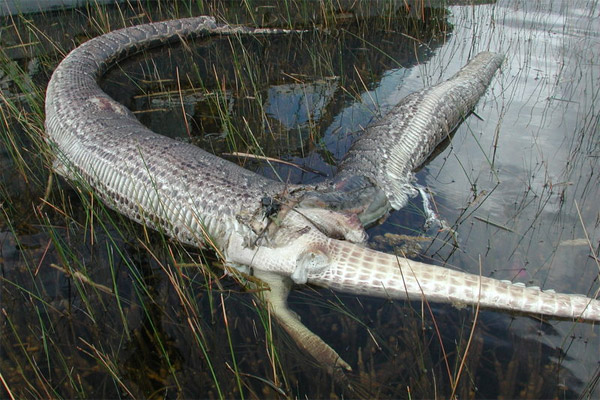 Burmese Python dead after attempting to eat an alligator in Florida in 2005. The Burmese python is an invasive species in the Everglades where it causes widespread problems, including feasting on native animals. Photo by Michael Barron A security guard at a hotel in Bali was killed after he tried to catch a 13-foot-long (4m) […]
Burmese Python dead after attempting to eat an alligator in Florida in 2005. The Burmese python is an invasive species in the Everglades where it causes widespread problems, including feasting on native animals. Photo by Michael Barron A security guard at a hotel in Bali was killed after he tried to catch a 13-foot-long (4m) […]
Sky islands: exploring East Africa’s last frontier
- The montane rainforests of East Africa are little-known to the global public.
- The Amazon and Congo loom much larger in our minds, while the savannas of East Africa remain the iconic ecosystems for the region.
- However these ancient, biodiverse forests – sitting on the tops of mountains rising from the African savanna –
are home to some remarkable species, many found only in a single forest.
- A team of international scientists – Michele Menegon, Fabio Pupin, and Simon Loader – have made it their mission to document the little-known reptiles and amphibians in these so-called sky islands, many of which are highly imperiled.
Not just bats and frogs: snake fungal disease hits U.S.
 A fungal outbreak in the eastern and Midwestern United States is infecting some populations of wild snakes. Snake Fungal Disease (SFD), a fungal dermatitis consistently associated with the fungus Ophidiomyces ophiodiicola, is showing recent spikes in occurrence according to the U.S. Geological Survey’s National Wildlife Health Center (NWHC) and other diagnostic laboratories. So far, the […]
A fungal outbreak in the eastern and Midwestern United States is infecting some populations of wild snakes. Snake Fungal Disease (SFD), a fungal dermatitis consistently associated with the fungus Ophidiomyces ophiodiicola, is showing recent spikes in occurrence according to the U.S. Geological Survey’s National Wildlife Health Center (NWHC) and other diagnostic laboratories. So far, the […]
Scientists catch boa constrictor eating a howler monkey (photos)
 In a world first, scientists have captured images and video of a boa constrictor attacking and devouring whole a femle howler monkey, one of the largest new world primates weighing in at around 4 kilograms (8.8 pounds). The rare predation event was recorded in a tiny forest fragment (2.5 hectares) in the Brazilian state of […]
In a world first, scientists have captured images and video of a boa constrictor attacking and devouring whole a femle howler monkey, one of the largest new world primates weighing in at around 4 kilograms (8.8 pounds). The rare predation event was recorded in a tiny forest fragment (2.5 hectares) in the Brazilian state of […]
Photo: Stunning new pit-viper discovered in Honduras
 A male Bothriechis guifarroi, the newly discovered green palm-pitviper from Honduras. Photo credit: Josiah H. Townsend A stunning new species of pit-viper has been discovered in the cloud forest of Honduras. The venomous snake is described in the journal ZooKeys. The species is named Bothriechis guifarroi in honor of Mario Guifarro of Olancho, a conservationist […]
A male Bothriechis guifarroi, the newly discovered green palm-pitviper from Honduras. Photo credit: Josiah H. Townsend A stunning new species of pit-viper has been discovered in the cloud forest of Honduras. The venomous snake is described in the journal ZooKeys. The species is named Bothriechis guifarroi in honor of Mario Guifarro of Olancho, a conservationist […]
Cobra bust in Vietnam
 Authorities in Vietnam arrested a man who they say was transporting 53 king cobras in his car, reports the Associated Press. The man said has was paid to transport the snakes, which are considered a delicacy by some in Vietnam and are sometimes used for traditional medicine. Police arrested the man and took the snakes […]
Authorities in Vietnam arrested a man who they say was transporting 53 king cobras in his car, reports the Associated Press. The man said has was paid to transport the snakes, which are considered a delicacy by some in Vietnam and are sometimes used for traditional medicine. Police arrested the man and took the snakes […]
Pictures: 20% of the world’s reptiles endangered
 Green iguana in Colombia. Photo by Rhett A. Butler Nearly a fifth the planet’s reptiles are threatened with extinction, warns a new assessment published in the journal Biological Conservation. The analysis, carried out by experts with the Zoological Society of London (ZSL) and the IUCN Species Survival Commission (SSC), is based on the extinction risk […]
Green iguana in Colombia. Photo by Rhett A. Butler Nearly a fifth the planet’s reptiles are threatened with extinction, warns a new assessment published in the journal Biological Conservation. The analysis, carried out by experts with the Zoological Society of London (ZSL) and the IUCN Species Survival Commission (SSC), is based on the extinction risk […]
Snake pictures celebrating the Year of the Snake
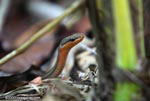 Sunday, February 10, marks start of Chinese New Year. 2013 is the “Year of the Snake” — specifically the water snake. The last Year of the Snake ran from January 23, 2001 to February 11, 2002. The last Year of the Water Snake took place from February 14, 1953 to February 2, 1954. The Year […]
Sunday, February 10, marks start of Chinese New Year. 2013 is the “Year of the Snake” — specifically the water snake. The last Year of the Snake ran from January 23, 2001 to February 11, 2002. The last Year of the Water Snake took place from February 14, 1953 to February 2, 1954. The Year […]
Animals of the Masai Mara – book review
 Spotted hyena in the Masai Mara. Photo by: Rhett A. Butler. Animals of the Masai Mara is the first illustrated guidebook to the Masai Mara region along the Kenya and Tanzania border. This is the world famous region of wildebeest migrations, large felines, towering African elephants, fascinating cultures, and great flora and fauna diversity. This […]
Spotted hyena in the Masai Mara. Photo by: Rhett A. Butler. Animals of the Masai Mara is the first illustrated guidebook to the Masai Mara region along the Kenya and Tanzania border. This is the world famous region of wildebeest migrations, large felines, towering African elephants, fascinating cultures, and great flora and fauna diversity. This […]
Pictures: 126 new species discovered in Greater Mekong region last year
 The Ruby-eyed pit viper (Trimeresurus rubeus) was discovered in the forest of Vietnam’s Cat Tien national park. Photograph: Peter Paul van Dijk/Darwin Initiative. Some 126 new species were described in Asia’a Mekong region last year, notes a new report published by the World Wildlife Fund (WWF). Extra Terrestrial — a follow up to last year’s […]
The Ruby-eyed pit viper (Trimeresurus rubeus) was discovered in the forest of Vietnam’s Cat Tien national park. Photograph: Peter Paul van Dijk/Darwin Initiative. Some 126 new species were described in Asia’a Mekong region last year, notes a new report published by the World Wildlife Fund (WWF). Extra Terrestrial — a follow up to last year’s […]
Birders urge ban on imports of 5 snake species
 The reticulated python. Photo by Rhett Butler. Bird conservationists in the United States are urging Congress to ban imports of five types of snakes that are considered a threat to native birds. In a letter sent the U.S. House Resource Committee, the American Bird Conservancy called for a ban on imports and inter-state trade in […]
The reticulated python. Photo by Rhett Butler. Bird conservationists in the United States are urging Congress to ban imports of five types of snakes that are considered a threat to native birds. In a letter sent the U.S. House Resource Committee, the American Bird Conservancy called for a ban on imports and inter-state trade in […]
Long and thin with a big head: new snake adds diversity to a bizarre group (photo)
 A live Imantodes chocoensis. Its head is about the size of an American penny. Photo by: Omar Torres-Carvajal et al. There’s no question that blunt-headed vine snakes are an odd lot: a thin body tapers into an even thinner neck which expands suddenly into a broad head with massive eyes. Until now only six species […]
A live Imantodes chocoensis. Its head is about the size of an American penny. Photo by: Omar Torres-Carvajal et al. There’s no question that blunt-headed vine snakes are an odd lot: a thin body tapers into an even thinner neck which expands suddenly into a broad head with massive eyes. Until now only six species […]
Indonesia remains epicenter for illegal wildlife trade in reptiles and amphibians
 Illegally traded lizards (left to right): black tree monitor (Varanus beccarii), Reisinger’s tree monitor (Varanus reisingeri), emerald monitor (Varanus prasinus), and the blue-spotted tree monitor (Varanus macraei). Photo courtesy of Jessica Lyons. Demand for exotic pets is driving the illegal harvest and trade of herpetofauna (reptiles and amphibians) in Indonesian New Guinea, according to a […]
Illegally traded lizards (left to right): black tree monitor (Varanus beccarii), Reisinger’s tree monitor (Varanus reisingeri), emerald monitor (Varanus prasinus), and the blue-spotted tree monitor (Varanus macraei). Photo courtesy of Jessica Lyons. Demand for exotic pets is driving the illegal harvest and trade of herpetofauna (reptiles and amphibians) in Indonesian New Guinea, according to a […]
Scientists name new snake species to criticize mine plans in Panama (photos)
 New snail-eating snake from Panama: Sibon noalamina. Non-venomous snail-eating snakes sport bright colors to mimic poisonous snakes as a defense. Photo © Sebastian Lotzkat. While scientists increasingly name new species after celebrities in order to gain much-needed attention for the world’s vanishing biodiversity, researchers describing a new snake species from Panama have taken a different […]
New snail-eating snake from Panama: Sibon noalamina. Non-venomous snail-eating snakes sport bright colors to mimic poisonous snakes as a defense. Photo © Sebastian Lotzkat. While scientists increasingly name new species after celebrities in order to gain much-needed attention for the world’s vanishing biodiversity, researchers describing a new snake species from Panama have taken a different […]
Arachnopocalypse: with birds away, the spiders play in Guam
 The accidental introduction of the brown tree snake on Guam has resulted in a loss of birds and a subsequent explosion of spiders. Photo by: Isaac Chellman. The island of Guam is drowning in spiders. New research in the open-access journal PLOS ONE has found that in the wet season, Guam’s arachnid population booms to […]
The accidental introduction of the brown tree snake on Guam has resulted in a loss of birds and a subsequent explosion of spiders. Photo by: Isaac Chellman. The island of Guam is drowning in spiders. New research in the open-access journal PLOS ONE has found that in the wet season, Guam’s arachnid population booms to […]
Pictures: Bolivian park may have the world’s highest biodiversity
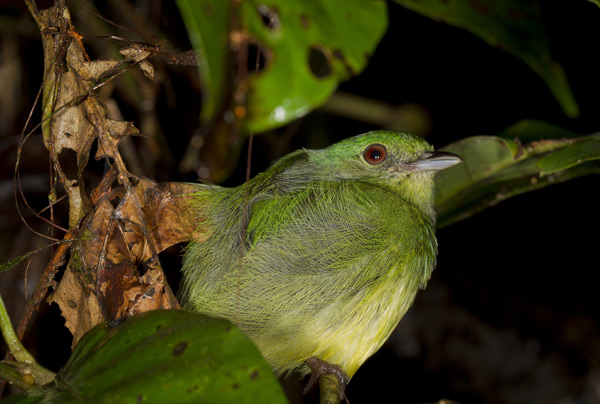 A female blue crowned manakin (Lepidothrix coronata) is one of over a thousand known bird species in Madidi National Park. Photo by: Mileniusz Spanowicz/WCS. With over 90 species of bat, 50 species of snake, 300 fish, 12,000 plants, and 11 percent of the world’s bird species, Madidi National Park in Bolivia may be the world’s […]
A female blue crowned manakin (Lepidothrix coronata) is one of over a thousand known bird species in Madidi National Park. Photo by: Mileniusz Spanowicz/WCS. With over 90 species of bat, 50 species of snake, 300 fish, 12,000 plants, and 11 percent of the world’s bird species, Madidi National Park in Bolivia may be the world’s […]
Massive snake found in Florida (photos)
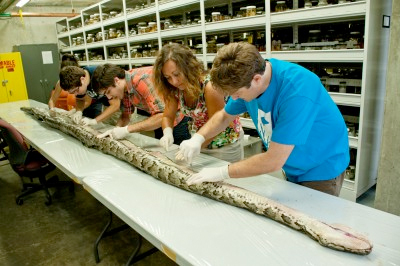 On Aug. 10, 2012, researchers at the Florida Museum of Natural History on the University of Florida campus examine the internal anatomy of the largest Burmese python found in Florida to date. The 17-foot-7-inch snake weighed 164 pounds and carried 87 eggs in its oviducts, a state record. Following scientific investigation, the snake will be […]
On Aug. 10, 2012, researchers at the Florida Museum of Natural History on the University of Florida campus examine the internal anatomy of the largest Burmese python found in Florida to date. The 17-foot-7-inch snake weighed 164 pounds and carried 87 eggs in its oviducts, a state record. Following scientific investigation, the snake will be […]
‘Beautiful’ new snake discovered in Cambodia (photo)
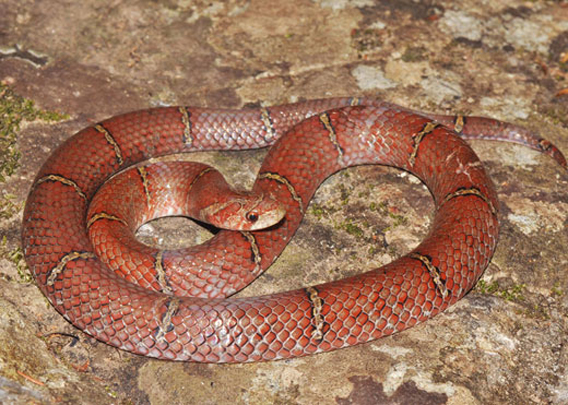 New species: the Cambodian kukri. Photo by: Photo: Neang Thy/FFI. Scientists have discovered a new snake species in the biodiverse rainforests of the Cardamom Mountains, reports Fauna & Flora International (FFI). The new reddish-hued serpent has been named after its country of origin by native herpetologist Neang Thy: the Cambodian kukri (Oligodon kampucheaensis). “Cambodian science […]
New species: the Cambodian kukri. Photo by: Photo: Neang Thy/FFI. Scientists have discovered a new snake species in the biodiverse rainforests of the Cardamom Mountains, reports Fauna & Flora International (FFI). The new reddish-hued serpent has been named after its country of origin by native herpetologist Neang Thy: the Cambodian kukri (Oligodon kampucheaensis). “Cambodian science […]
Meet the world’s rarest snake: only 18 left
-(Large).568.jpg) World’s rarest snake: Saint Lucia racer. Photo by: G. Guida. It’s slithery, brown, and doesn’t mind being picked up: meet the Saint Lucia racer (Liophis ornatus), which holds the dubious honor of being the world’s most endangered snake. A five month extensive survey found just 18 animals on a small islet off of the Caribbean […]
World’s rarest snake: Saint Lucia racer. Photo by: G. Guida. It’s slithery, brown, and doesn’t mind being picked up: meet the Saint Lucia racer (Liophis ornatus), which holds the dubious honor of being the world’s most endangered snake. A five month extensive survey found just 18 animals on a small islet off of the Caribbean […]
96 percent of the world’s species remain unevaluated by the Red List
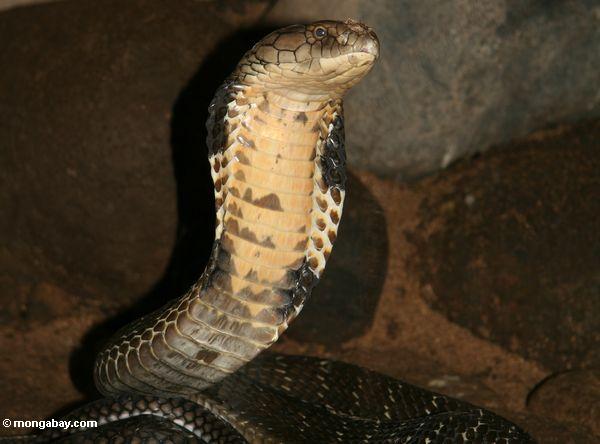 The IUCN Red List releases its 2012 update, adding 247 species to its threatened categories. The king cobra has been evaluated by the IUCN Red List for the first time and listed as Vulnerable. Photo by: Rhett A. Butler. Nearly 250 species have been added to the threatened categories—i.e. Vulnerable, Endangered, and Critically Endangered—in this […]
The IUCN Red List releases its 2012 update, adding 247 species to its threatened categories. The king cobra has been evaluated by the IUCN Red List for the first time and listed as Vulnerable. Photo by: Rhett A. Butler. Nearly 250 species have been added to the threatened categories—i.e. Vulnerable, Endangered, and Critically Endangered—in this […]
Herp paradise preserved in Guatemala
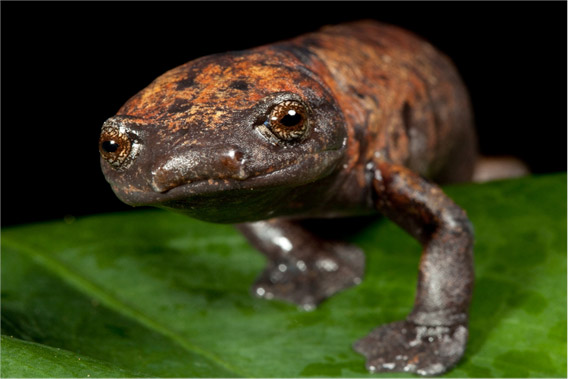 Giant Palm Footed Salamander (Bolitoglossa dofleini). Photo by Robin Moore/robindmoore.com. Fifteen conservation groups have banded together to save around 2,400 hectares (6,000 acres) of primary rainforest in Guatemala, home to a dozen imperiled amphibians as well as the recently discovered Merendon palm pit viper (Bothriechis thalassinus). The new park, dubbed the Sierra Caral Amphibian Reserve, […]
Giant Palm Footed Salamander (Bolitoglossa dofleini). Photo by Robin Moore/robindmoore.com. Fifteen conservation groups have banded together to save around 2,400 hectares (6,000 acres) of primary rainforest in Guatemala, home to a dozen imperiled amphibians as well as the recently discovered Merendon palm pit viper (Bothriechis thalassinus). The new park, dubbed the Sierra Caral Amphibian Reserve, […]
Scientists discover deadly new sea snake
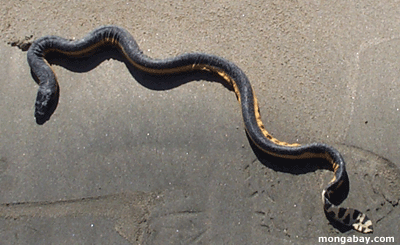 Scientists in Australia have discovered a species of sea snake in estuaries of the Gulf of Carpenteria in northern Australia. The snake is described in the current issue of Zootaxa. The species, dubbed Hydrophis donaldii after the discover’s boat captain David Donald, is distinguished from other related sea snakes by its “raised” scales. Its common […]
Scientists in Australia have discovered a species of sea snake in estuaries of the Gulf of Carpenteria in northern Australia. The snake is described in the current issue of Zootaxa. The species, dubbed Hydrophis donaldii after the discover’s boat captain David Donald, is distinguished from other related sea snakes by its “raised” scales. Its common […]
Malaysia drops the ball on wildlife trafficking, says group
 Malaysia failed to effectively assemble a case against convicted wildlife smuggler Anson Wong, leading to his early release from prison, says an anti-wildlife trafficking group. Wong was released yesterday after serving under a third of his his five-year prison term for wildlife trafficking. Wong was arrested in 2010 after a luggage malfunction led Malaysia Airlines […]
Malaysia failed to effectively assemble a case against convicted wildlife smuggler Anson Wong, leading to his early release from prison, says an anti-wildlife trafficking group. Wong was released yesterday after serving under a third of his his five-year prison term for wildlife trafficking. Wong was arrested in 2010 after a luggage malfunction led Malaysia Airlines […]
‘Snakes on a Plane’ trafficker freed early from jail
 Notorious wildlife trafficker Anson Wong has been freed from prison after a court reduced his five-year term, reports Malaysian state media. Wong had served 17-and-a-half-months for illegally exporting nearly 100 reptiles from Malaysia. Wong was arrested in 2010 after a luggage malfunction led Malaysia Airlines security staff revealed he was illegally carrying 95 boa constrictors, […]
Notorious wildlife trafficker Anson Wong has been freed from prison after a court reduced his five-year term, reports Malaysian state media. Wong had served 17-and-a-half-months for illegally exporting nearly 100 reptiles from Malaysia. Wong was arrested in 2010 after a luggage malfunction led Malaysia Airlines security staff revealed he was illegally carrying 95 boa constrictors, […]
Invasion!: Burmese pythons decimate mammals in the Everglades
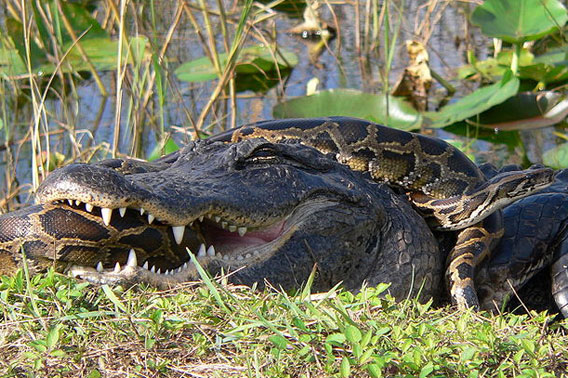 An American alligator and a Burmese python struggle in Everglades National Park. Photo by: Lori Oberhofer, U.S. National Park Service. The Everglades in southern Florida has faced myriad environmental impacts from draining for sprawl to the construction of canals, but even as the U.S. government moves slowly on an ambitious plan to restore the massive […]
An American alligator and a Burmese python struggle in Everglades National Park. Photo by: Lori Oberhofer, U.S. National Park Service. The Everglades in southern Florida has faced myriad environmental impacts from draining for sprawl to the construction of canals, but even as the U.S. government moves slowly on an ambitious plan to restore the massive […]
U.S. implements snake ban to save native ecosystems
 An American alligator and a Burmese python struggle in Everglades National Park. Photo by: Lori Oberhofer, U.S. National Park Service. Last week the U.S. Fish and Wildlife Service (USFWS) announced it was banning the importation and sale across state lines of four large, non-native snakes: the Burmese python (Python molurus bivittatus), the yellow anaconda (Eunectes […]
An American alligator and a Burmese python struggle in Everglades National Park. Photo by: Lori Oberhofer, U.S. National Park Service. Last week the U.S. Fish and Wildlife Service (USFWS) announced it was banning the importation and sale across state lines of four large, non-native snakes: the Burmese python (Python molurus bivittatus), the yellow anaconda (Eunectes […]
Will Taiwan save its last pristine coastline?
 The Alangyi coastline. Photo by: Pierre Fidenci. Voters in the January 14 Taiwanese presidential election will decide the fate of the island’s last pristine wilderness known as the Alangyi Trail. Amongst the three candidates, only one (Tsai Ing-wen from the Democratic Progressive Party) may support the conservation of Alangyi Trail and its coastline. One of […]
The Alangyi coastline. Photo by: Pierre Fidenci. Voters in the January 14 Taiwanese presidential election will decide the fate of the island’s last pristine wilderness known as the Alangyi Trail. Amongst the three candidates, only one (Tsai Ing-wen from the Democratic Progressive Party) may support the conservation of Alangyi Trail and its coastline. One of […]
The dark side of new species discovery
 This interview is an excerpt from The WildLife with Laurel Neme, a program that explores the mysteries of the animal world through interviews with scientists and other wildlife investigators. “The WildLife” airs every Monday from 1-2 pm EST on WOMM-LP, 105.9 FM in Burlington, Vermont. You can livestream it at theradiator.org or download the podcast […]
This interview is an excerpt from The WildLife with Laurel Neme, a program that explores the mysteries of the animal world through interviews with scientists and other wildlife investigators. “The WildLife” airs every Monday from 1-2 pm EST on WOMM-LP, 105.9 FM in Burlington, Vermont. You can livestream it at theradiator.org or download the podcast […]
Herpetology curator: behind-the-scenes of ‘new species’ discoveries
 This interview is an excerpt from The WildLife with Laurel Neme, a program that explores the mysteries of the animal world through interviews with scientists and other wildlife investigators. “The WildLife” airs every Monday from 1-2 pm EST on WOMM-LP, 105.9 FM in Burlington, Vermont. You can livestream it at theradiator.org or download the podcast […]
This interview is an excerpt from The WildLife with Laurel Neme, a program that explores the mysteries of the animal world through interviews with scientists and other wildlife investigators. “The WildLife” airs every Monday from 1-2 pm EST on WOMM-LP, 105.9 FM in Burlington, Vermont. You can livestream it at theradiator.org or download the podcast […]
New large horned viper discovered, but biologists keep location quiet
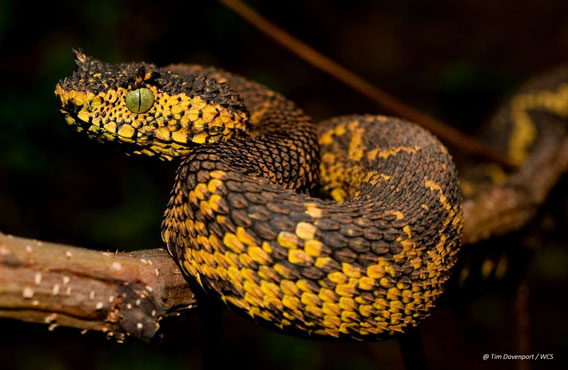 Matilda’s horned viper. Photo by: Tim Davenport. In a remote forest fragment in Tanzania, scientists have made a remarkable discovery: a uniquely-colored horned viper extending over two feet long (643 millimeters) that evolved from its closest relative over two million years ago. Unfortunately, however, the new species—named Matilda’s horned viper (Atheris matildae)—survives in a small […]
Matilda’s horned viper. Photo by: Tim Davenport. In a remote forest fragment in Tanzania, scientists have made a remarkable discovery: a uniquely-colored horned viper extending over two feet long (643 millimeters) that evolved from its closest relative over two million years ago. Unfortunately, however, the new species—named Matilda’s horned viper (Atheris matildae)—survives in a small […]
Giant snakes commonly attacked modern hunter-gatherers in Philippines
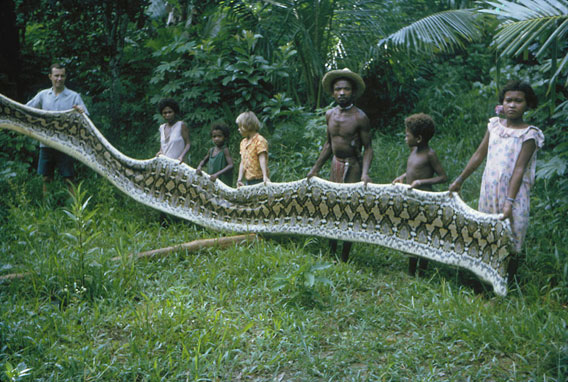 Skin of female python killed by Agta Negrito men. Photo by: J. Headland. Humans have an ambivalent relationship with snakes. The legless reptiles are often feared and reviled, becoming stand-ins for the Devil and movie monster characters; yet many people have grown to love snakes, raising large, even dangerous, specimens as pets. Now, new research […]
Skin of female python killed by Agta Negrito men. Photo by: J. Headland. Humans have an ambivalent relationship with snakes. The legless reptiles are often feared and reviled, becoming stand-ins for the Devil and movie monster characters; yet many people have grown to love snakes, raising large, even dangerous, specimens as pets. Now, new research […]
$500 offered for rediscovery of extinct snake
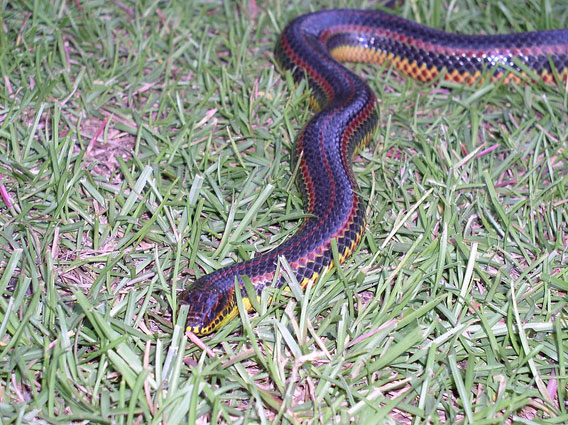 Rainbow snake, of which the South Florida rainbow snake is a subspecies. Photo by: Alan Garrett. Need to make a quick 500 bucks? Easy: head to Glades County, Florida and find a specimen of the South Florida rainbow snake (Farancia erytrogramma seminola), which the US government says is extinct. In an unusual bid two NGOS, […]
Rainbow snake, of which the South Florida rainbow snake is a subspecies. Photo by: Alan Garrett. Need to make a quick 500 bucks? Easy: head to Glades County, Florida and find a specimen of the South Florida rainbow snake (Farancia erytrogramma seminola), which the US government says is extinct. In an unusual bid two NGOS, […]
Snake laundering rampant in the Indonesian reptile export market
 Often lauded as a model for conserving wild populations, breeding centers in Indonesia are shown to be actually worsening depletion of wildlife. Green tree python Breeding farms in Indonesia are being used to launder illegally caught wildlife, finds a new study published in the journal Biological Conservation. The research is based on surveys of traders […]
Often lauded as a model for conserving wild populations, breeding centers in Indonesia are shown to be actually worsening depletion of wildlife. Green tree python Breeding farms in Indonesia are being used to launder illegally caught wildlife, finds a new study published in the journal Biological Conservation. The research is based on surveys of traders […]
Photos: Halloween creepy-crawlies of the natural world
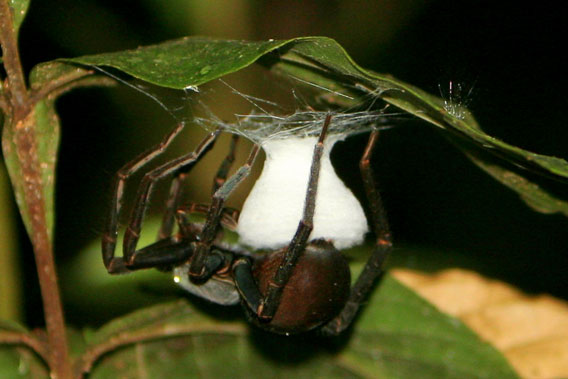 Everyone loves the beautiful animals, the playful orangutans, the rolly-polly pandas, the regal tigers, the wise elephants, the awe-inspiring whales, the silly penguins—and it shows. Aside from gracing calendars and starring in movies, these species receive millions in conservation funds and have no shortage of researchers devoted to them. But what about the ugly, crawly, […]
Everyone loves the beautiful animals, the playful orangutans, the rolly-polly pandas, the regal tigers, the wise elephants, the awe-inspiring whales, the silly penguins—and it shows. Aside from gracing calendars and starring in movies, these species receive millions in conservation funds and have no shortage of researchers devoted to them. But what about the ugly, crawly, […]
Old trees necessary for nesting animals
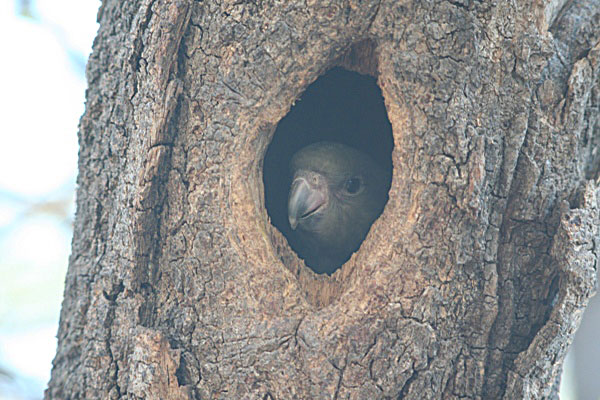 Brown-headed parrot (Poicephalus cryptoxanthus) fledgling in tree cavity in Botswana. Photo by: Tiffany Roufs. Aged, living trees are essential for over 1,000 birds and mammals that depend on such trees for nesting holes, according to a study in Frontiers in Ecology and the Environment. In much of the world, tree-nesting animals depend on holes formed […]
Brown-headed parrot (Poicephalus cryptoxanthus) fledgling in tree cavity in Botswana. Photo by: Tiffany Roufs. Aged, living trees are essential for over 1,000 birds and mammals that depend on such trees for nesting holes, according to a study in Frontiers in Ecology and the Environment. In much of the world, tree-nesting animals depend on holes formed […]
Little-known animal picture of the day: salmon-bellied snake
 Salmon-bellied snake . Photo by: Rhett A. Butler. The salmon-bellied snake (Mastigodryas melanolomus) is found in Central American forests, savannas, and even agricultural areas. It preys on lizards, frogs, and rodents. Described as ‘very adaptable’ by the IUCN Red List the snake is listed as Least Concern. For more photos of snakes in Costa Rica […]
Salmon-bellied snake . Photo by: Rhett A. Butler. The salmon-bellied snake (Mastigodryas melanolomus) is found in Central American forests, savannas, and even agricultural areas. It preys on lizards, frogs, and rodents. Described as ‘very adaptable’ by the IUCN Red List the snake is listed as Least Concern. For more photos of snakes in Costa Rica […]
Florida loses two species to extinction
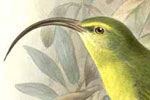 The US Fish and Wildlife Service announced yesterday that the believe two species in Florida have vanished into the long dark night: the South Florida rainbow snake (Farancia erytrogramma seminola) and the Florida fairy shrimp (Dexteria floridana). The species were under review for possibly being added to the Endangered Species Act (ESA), but it’s likely […]
The US Fish and Wildlife Service announced yesterday that the believe two species in Florida have vanished into the long dark night: the South Florida rainbow snake (Farancia erytrogramma seminola) and the Florida fairy shrimp (Dexteria floridana). The species were under review for possibly being added to the Endangered Species Act (ESA), but it’s likely […]
Picture of the day: milking a fer-de-lance
 Fer de lances are ‘milked’ in order to extract the venom to create anti-venom. This photo was taken in Amacayacu National Park in Colombia. Photo by: Rhett A. Butler. If you’re unfortunate enough to be bit by a venomous snake in South America, its most likely the fer-de-lance (Bothrops atrox). Found in both forests and […]
Fer de lances are ‘milked’ in order to extract the venom to create anti-venom. This photo was taken in Amacayacu National Park in Colombia. Photo by: Rhett A. Butler. If you’re unfortunate enough to be bit by a venomous snake in South America, its most likely the fer-de-lance (Bothrops atrox). Found in both forests and […]
Escaped Bronx Zoo cobra found! (picture)
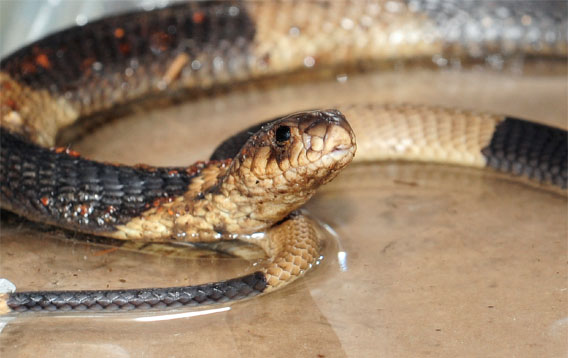 The missing Bronx Zoo cobra has been recaptured. Photo by Julie Larsen Maher of WCS. The missing Bronx Zoo cobra that became a pop culture sensation and caused consternation among some New York residents whas been found after a thorough search of the zoo’s Reptile House. The escaped serpent was found in a non-public, off-exhibit […]
The missing Bronx Zoo cobra has been recaptured. Photo by Julie Larsen Maher of WCS. The missing Bronx Zoo cobra that became a pop culture sensation and caused consternation among some New York residents whas been found after a thorough search of the zoo’s Reptile House. The escaped serpent was found in a non-public, off-exhibit […]
Photo: new vipers discovered in Asia’s rainforests
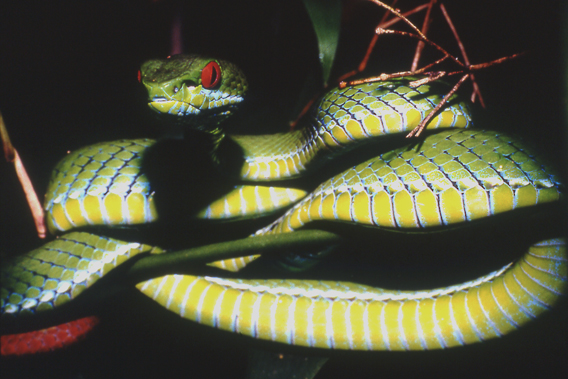 Hard to miss the bright red ruby eyes of the world’s newest pitviper: Cryptelytrops rubeus. Photo ©: Peter Paul van Dijk. Researchers have discovered two new species of pitviper in Southeast Asia. After collecting snakes throughout the Asian tropics—Thailand, Laos, Vietnam, and Cambodia—researchers were able to parse out a more complex set of species than […]
Hard to miss the bright red ruby eyes of the world’s newest pitviper: Cryptelytrops rubeus. Photo ©: Peter Paul van Dijk. Researchers have discovered two new species of pitviper in Southeast Asia. After collecting snakes throughout the Asian tropics—Thailand, Laos, Vietnam, and Cambodia—researchers were able to parse out a more complex set of species than […]
Malaysian customs seizes 1,800 trafficked reptiles
 Malaysia contains an amazing array of plants and animals, including this water monitor. Photo taken in Sabah by Rhett A. Butler Malaysia ended 2010 with the confiscation of 4.3 metric tons of reptiles near the Thai border on December 20th, reports the Wildlife Trade Monitoring Network, TRAFFIC. The confiscation was the largest of the year […]
Malaysia contains an amazing array of plants and animals, including this water monitor. Photo taken in Sabah by Rhett A. Butler Malaysia ended 2010 with the confiscation of 4.3 metric tons of reptiles near the Thai border on December 20th, reports the Wildlife Trade Monitoring Network, TRAFFIC. The confiscation was the largest of the year […]
Pemerintah A.S. Bom Guam dengan Tikus Beku untuk Bunuh Ular
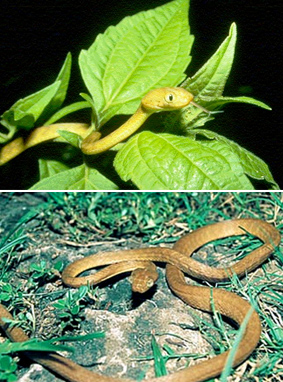 Dengan usaha yang sangat kreatif untuk menyingkirkan spesies agresif, Departemen Pertanian AS merencanakan untuk menjatuhkan ‘bom’ di hutan hujan pulau Guam dengan tikus beku mati yang dilapisi acetaminophen. Bom-tikus ini ditargetkan pada ular pohon cokelat, spesies penyerang yang telah membinasakan kehidupan alam setempat, dan membuat marah penduduk setempat, sejak muncul di tahun 1940-an. Idenya adalah […]
Dengan usaha yang sangat kreatif untuk menyingkirkan spesies agresif, Departemen Pertanian AS merencanakan untuk menjatuhkan ‘bom’ di hutan hujan pulau Guam dengan tikus beku mati yang dilapisi acetaminophen. Bom-tikus ini ditargetkan pada ular pohon cokelat, spesies penyerang yang telah membinasakan kehidupan alam setempat, dan membuat marah penduduk setempat, sejak muncul di tahun 1940-an. Idenya adalah […]
Wildlife trafficker gets 5 years in Malaysian prison
 A Malaysian court sentenced notorious wildlife trafficker Anson Wong to five years in jail, reports The Star. Justice Mohtarudin Baki ruled for the longer sentence after an appeal by the Attorney-General’s Chambers. Wong is expected to appeal. The judge also ordered the 190,000 Malaysian ringgit ($61,000) fine imposed on Wong to be returned to him. […]
A Malaysian court sentenced notorious wildlife trafficker Anson Wong to five years in jail, reports The Star. Justice Mohtarudin Baki ruled for the longer sentence after an appeal by the Attorney-General’s Chambers. Wong is expected to appeal. The judge also ordered the 190,000 Malaysian ringgit ($61,000) fine imposed on Wong to be returned to him. […]
Biological shocker: snake reproduces asexually
 Researchers have discovered a biological shocker: female boa constrictors are capable of giving birth asexually. But the surprise doesn’t end there. The study in Biology Letters found that boa babies produced through this asexual reproduction—also known as parthenogenesis—sport a chromosomal oddity that researchers thought was impossible in reptiles. While researchers admit that the female in […]
Researchers have discovered a biological shocker: female boa constrictors are capable of giving birth asexually. But the surprise doesn’t end there. The study in Biology Letters found that boa babies produced through this asexual reproduction—also known as parthenogenesis—sport a chromosomal oddity that researchers thought was impossible in reptiles. While researchers admit that the female in […]
World’s rarest snake making a comeback
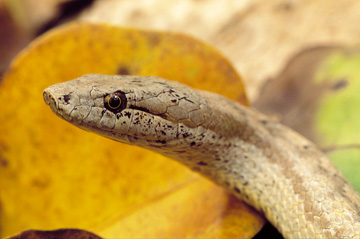 The Antiguan racer (Alsophis antiguae) shares a similar story with many highly endangered island species. Invasive mongoose killed every racer on the Caribbean island of Antigua, leaving only a small population on nearby Great Bird Island. Confined to 8 hectares, this final population was being killed-off by invasive Eurasian black rats. By the time conservationists […]
The Antiguan racer (Alsophis antiguae) shares a similar story with many highly endangered island species. Invasive mongoose killed every racer on the Caribbean island of Antigua, leaving only a small population on nearby Great Bird Island. Confined to 8 hectares, this final population was being killed-off by invasive Eurasian black rats. By the time conservationists […]
Life shocker: new species discovered every three days in the Amazon
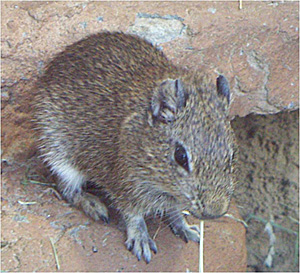 A look back at species discovered over the last decade in the Amazon. A new report by the World Wide Fund for Nature (WWF) confirms the Amazon rainforest, even as it is shrinking due to deforestation, remains among the world’s most surprising places. According to the report, Amazon Alive, over the past decade (1999-2009) researchers […]
A look back at species discovered over the last decade in the Amazon. A new report by the World Wide Fund for Nature (WWF) confirms the Amazon rainforest, even as it is shrinking due to deforestation, remains among the world’s most surprising places. According to the report, Amazon Alive, over the past decade (1999-2009) researchers […]
Wildlife permits revoked for ‘Snakes on a Plane’ animal trafficker in Malaysia
 Wildlife smuggler Anson Wong and his wife Cheah Bing Shee had their business licenses and wildlife permits revoked after the notorious trafficker was convicted of attempting to illegally take nearly 100 snakes out of Malaysia, reports The Star. The Natural Resources and Environment Ministry said the National Wildlife and Parks Department (Perhilitan) intends to confiscate […]
Wildlife smuggler Anson Wong and his wife Cheah Bing Shee had their business licenses and wildlife permits revoked after the notorious trafficker was convicted of attempting to illegally take nearly 100 snakes out of Malaysia, reports The Star. The Natural Resources and Environment Ministry said the National Wildlife and Parks Department (Perhilitan) intends to confiscate […]
U.S. government bombs Guam with frozen mice to kill snakes
 In a spectacularly creative effort to rid Guam of an invasive species, the US Department of Agriculture is planning to ‘bomb’ the island’s rainforests with dead frozen mice laced with acetaminophen. The mice-bombs are meant to target the brown tree snake, an invasive species which has ravaged local wildlife, and angered local residents, since arriving […]
In a spectacularly creative effort to rid Guam of an invasive species, the US Department of Agriculture is planning to ‘bomb’ the island’s rainforests with dead frozen mice laced with acetaminophen. The mice-bombs are meant to target the brown tree snake, an invasive species which has ravaged local wildlife, and angered local residents, since arriving […]
‘Snakes on a plane’ trafficker gets 6 months in jail
 Why biodiversity matters for carbon storage Notorious wildlife trafficker Anson Wong has been fined 190,000 Malaysian ringgit ($61,000) and sentenced to 6 months in jail for attempting to smuggle 95 boa constrictors, reports the Malaysian Star. Anson Wong, made famous in The Lizard King, a book by Bryan Christy that exposed his trafficking activities, was […]
Why biodiversity matters for carbon storage Notorious wildlife trafficker Anson Wong has been fined 190,000 Malaysian ringgit ($61,000) and sentenced to 6 months in jail for attempting to smuggle 95 boa constrictors, reports the Malaysian Star. Anson Wong, made famous in The Lizard King, a book by Bryan Christy that exposed his trafficking activities, was […]
Snakes on a plane! Malaysian reptile trafficker busted at airport
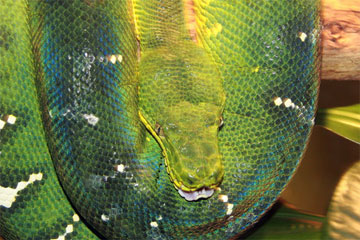 A notorious reptile smuggler has been busted at Malaysia Kuala Lumpur International Airport after his luggage was found to contain 98 snakes and a turtle, reports the Malaysian Star. Anson Wong, made famous in The Lizard King, a book by Bryan Christy that exposed his trafficking activities, was taken into custody by police after being […]
A notorious reptile smuggler has been busted at Malaysia Kuala Lumpur International Airport after his luggage was found to contain 98 snakes and a turtle, reports the Malaysian Star. Anson Wong, made famous in The Lizard King, a book by Bryan Christy that exposed his trafficking activities, was taken into custody by police after being […]
Study points to global snake decline
 A number of reports over the last decade have shown amphibians, lizards, fish, and birds facing steep population declines across species and continents, providing further evidence that the planet is undergoing a mass extinction. Now a new study in Biology Letters adds another group of animals to that list: snakes. Studying 17 snake populations from […]
A number of reports over the last decade have shown amphibians, lizards, fish, and birds facing steep population declines across species and continents, providing further evidence that the planet is undergoing a mass extinction. Now a new study in Biology Letters adds another group of animals to that list: snakes. Studying 17 snake populations from […]
New blind snake discovery
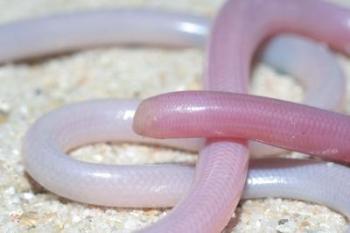 World-traveling blindsnake points to Madagascar’s origins and great voyages across the Atlantic. Call them survivors: blindsnakes have been identified as one of the few groups of organisms that inhabited Madagascar when it broke from the Indian subcontinent around 100 million years ago. According to a new study in Biology Letters, blindsnakes not only survived the […]
World-traveling blindsnake points to Madagascar’s origins and great voyages across the Atlantic. Call them survivors: blindsnakes have been identified as one of the few groups of organisms that inhabited Madagascar when it broke from the Indian subcontinent around 100 million years ago. According to a new study in Biology Letters, blindsnakes not only survived the […]
Secrets of the Amazon: giant anacondas and floating forests, an interview with Paul Rosolie
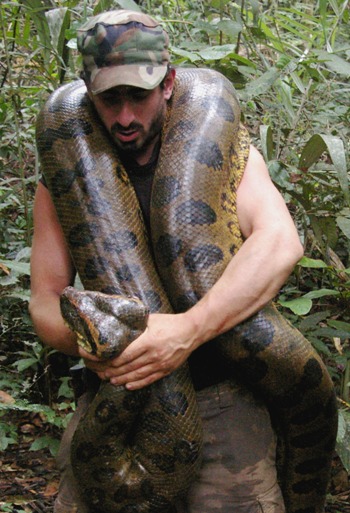 Paul Rosolie leads volunteer expeditions into the Peruvian rainforest with an aim towards education and grassroots conservation. Mongabay.com’s eighth in its series of interviews with ‘Young Scientists’. At twenty-two Paul Rosolie has seen more adventure than many of us will in our lifetime. First visiting the Amazon at eighteen, Rosolie has explored strange jungle ecosystems, […]
Paul Rosolie leads volunteer expeditions into the Peruvian rainforest with an aim towards education and grassroots conservation. Mongabay.com’s eighth in its series of interviews with ‘Young Scientists’. At twenty-two Paul Rosolie has seen more adventure than many of us will in our lifetime. First visiting the Amazon at eighteen, Rosolie has explored strange jungle ecosystems, […]
Prehistoric snake gobbled-up dinosaur babies
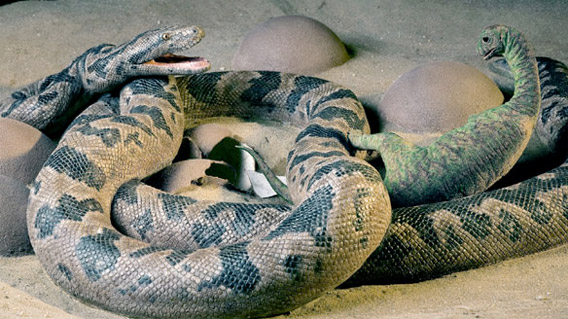 Sauropod babies for breakfast A fossilized snake has been discovered inside a titanosaur nest in India, leading researchers to conclude that the snake fed on newly-hatched dinosaur babies, rather than their eggs like modern snakes. Paleontologist and snake expert Jason Head says that the snake, known as Sanajeh indicus, lacked the wipe-jaws needed to swallow […]
Sauropod babies for breakfast A fossilized snake has been discovered inside a titanosaur nest in India, leading researchers to conclude that the snake fed on newly-hatched dinosaur babies, rather than their eggs like modern snakes. Paleontologist and snake expert Jason Head says that the snake, known as Sanajeh indicus, lacked the wipe-jaws needed to swallow […]
Starving hyenas kill and eat 12-foot-long python during drought
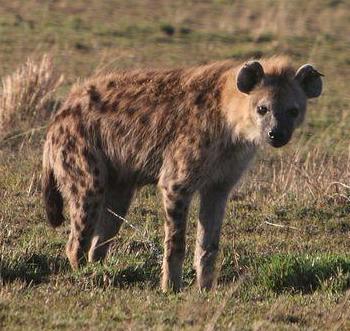 Members with the conservation group Lion Guardians stumbled on a rare site in the Amboseli area of Kenya recently: six hyenas and a number of jackals were attacking and eating a 12-foot-long python. On their blog at WildlifeDirect, Lion Guardians describe the attack: “[the hyenas and jackals] tore into its body from the back, and […]
Members with the conservation group Lion Guardians stumbled on a rare site in the Amboseli area of Kenya recently: six hyenas and a number of jackals were attacking and eating a 12-foot-long python. On their blog at WildlifeDirect, Lion Guardians describe the attack: “[the hyenas and jackals] tore into its body from the back, and […]
Guyana expedition finds biodiversity trove in area slated for oil and gas development, an interview with Robert Pickles
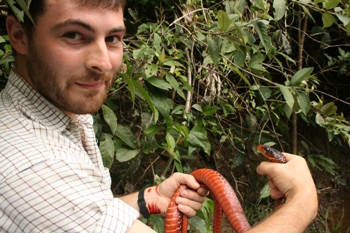 Playful giant river otters, massive anacondas, unafraid tapirs, and the world’s largest spider recorded in Guyana’s lost world. An expedition deep into Guyana’s rainforest interior to find the endangered giant river otter—and collect their scat for genetic analysis—uncovered much more than even this endangered charismatic species. “Visiting the Rewa Head felt like we were walking […]
Playful giant river otters, massive anacondas, unafraid tapirs, and the world’s largest spider recorded in Guyana’s lost world. An expedition deep into Guyana’s rainforest interior to find the endangered giant river otter—and collect their scat for genetic analysis—uncovered much more than even this endangered charismatic species. “Visiting the Rewa Head felt like we were walking […]
New killer snake invades Florida
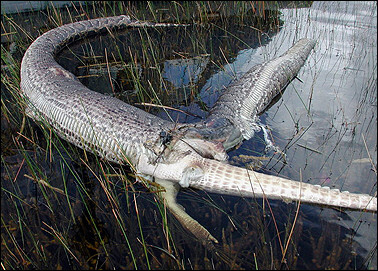 A new invasive python in Florida may be worse than the species already causing ecological havoc across the Everglades, reports the Miami Herald. A recent string of captures of African rock pythons has authorities worried that the species, smaller but much more aggressive than the already-established Burmese python, is getting a foothold in the state. […]
A new invasive python in Florida may be worse than the species already causing ecological havoc across the Everglades, reports the Miami Herald. A recent string of captures of African rock pythons has authorities worried that the species, smaller but much more aggressive than the already-established Burmese python, is getting a foothold in the state. […]
Florida announces python hunt following snake invasion
 Florida has authorized a cull of Burmese pythons that have invaded the Everglades and other wetland areas, reports the Associated Press. A spokeswoman for the Florida Fish and Wildlife Conservation Commission, Pat Behnke, said ten snake-hunters would be dispatched to capture and euthanize Burmese pythons two weeks after the death of a toddler in her […]
Florida has authorized a cull of Burmese pythons that have invaded the Everglades and other wetland areas, reports the Associated Press. A spokeswoman for the Florida Fish and Wildlife Conservation Commission, Pat Behnke, said ten snake-hunters would be dispatched to capture and euthanize Burmese pythons two weeks after the death of a toddler in her […]
Photos of ‘100-foot monster snake’ surface

Monstrous prehistoric snake provides glimpse of warmer tropical forests
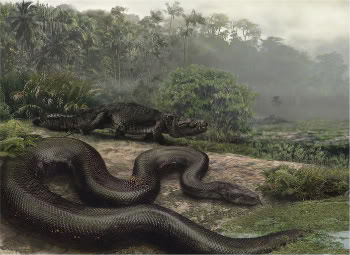
World’s largest snake discovered: prehistoric serpent was twice the size of an anaconda

Rare rhino rat snake hatches in London zoo
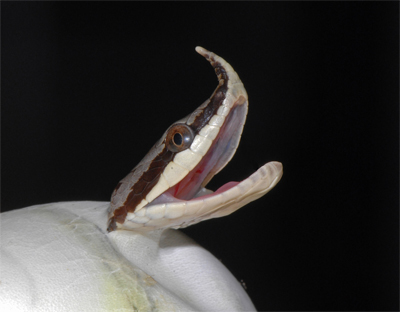 Photos: Rare rhino rat snake hatches in London zoo Rare rhino rat snake hatches in London zoo Jeremy Hance, mongabay.com November 13, 2008
Photos: Rare rhino rat snake hatches in London zoo Rare rhino rat snake hatches in London zoo Jeremy Hance, mongabay.com November 13, 2008
Scientists discover world’s smallest snake species
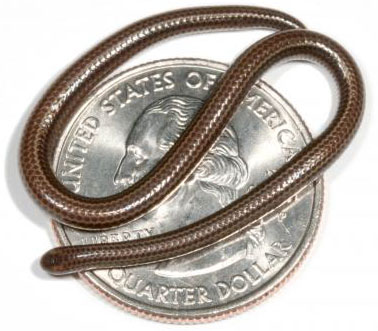 Photos of the world’s smallest snake species Photo: Scientists discover world’s smallest snake species Jeremy Hance, mongabay.com August 3, 2008 If one wanted to overcome their fear of snakes, they may want to start with the newly discovered Leptotyphlops carlae. Measuring less than four inches long, even stretched out this new species of threadsnake can’t […]
Photos of the world’s smallest snake species Photo: Scientists discover world’s smallest snake species Jeremy Hance, mongabay.com August 3, 2008 If one wanted to overcome their fear of snakes, they may want to start with the newly discovered Leptotyphlops carlae. Measuring less than four inches long, even stretched out this new species of threadsnake can’t […]
Deforestation causes snake invasion in the Amazon
 An official with Brazil’s environmental protection agency Ibama claims that snakes are invading the city of Belem due to deforestation of the Amazon rainforest. Interviewed by the Associated Press, Ibama press officer Luciana Almeida said the agency has been called out to capture 21 snakes this year in the Amazonian city of 1.5 million. She […]
An official with Brazil’s environmental protection agency Ibama claims that snakes are invading the city of Belem due to deforestation of the Amazon rainforest. Interviewed by the Associated Press, Ibama press officer Luciana Almeida said the agency has been called out to capture 21 snakes this year in the Amazonian city of 1.5 million. She […]
World’s largest spitting cobra discovered in Kenya
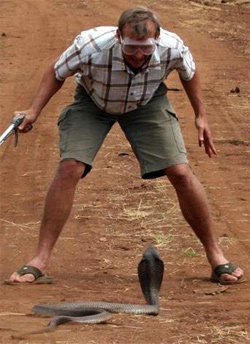 Photos: world’s largest spitting cobra discovered in Kenya Photos: world’s largest spitting cobra discovered in Kenya Rhett A. Butler, mongabay.com December 9, 2007 The world’s largest spitting cobra has been discovered in Kenya, according to WildlifeDirect, a conservation group. Picture by Anton Childs Picture by Bonnie Sare Picture by Royjan Taylor Picture by Bonnie Sare […]
Photos: world’s largest spitting cobra discovered in Kenya Photos: world’s largest spitting cobra discovered in Kenya Rhett A. Butler, mongabay.com December 9, 2007 The world’s largest spitting cobra has been discovered in Kenya, according to WildlifeDirect, a conservation group. Picture by Anton Childs Picture by Bonnie Sare Picture by Royjan Taylor Picture by Bonnie Sare […]
Snake uses trick to avoid poisoning from toxic frogs
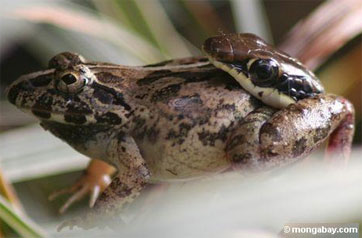 Snake uses trick to avoid poisoning from toxic frogs Snake uses trick to avoid poisoning from toxic frogs mongabay.com October 16, 2007 An Australian snake employs a special feeding behavior to avoid poisoning by toxic frogs, reports The American Naturalist. University of Sydney scientists Ben Phillips and Richards Shine found that the northern death adder […]
Snake uses trick to avoid poisoning from toxic frogs Snake uses trick to avoid poisoning from toxic frogs mongabay.com October 16, 2007 An Australian snake employs a special feeding behavior to avoid poisoning by toxic frogs, reports The American Naturalist. University of Sydney scientists Ben Phillips and Richards Shine found that the northern death adder […]
How do snakes survive starvation?
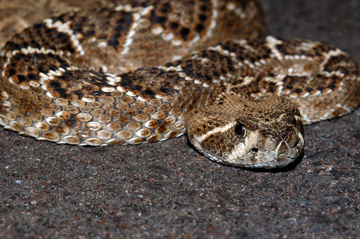 How do snakes survive starvation? How do snakes survive starvation? University of Arkansas, Fayetteville August 27, 2007 Starving snakes employ novel survival strategies not seen before in vertebrates, according to research conducted by a University of Arkansas biologist. These findings could be used in conservation strategies to determine the health of snake populations. “These animals […]
How do snakes survive starvation? How do snakes survive starvation? University of Arkansas, Fayetteville August 27, 2007 Starving snakes employ novel survival strategies not seen before in vertebrates, according to research conducted by a University of Arkansas biologist. These findings could be used in conservation strategies to determine the health of snake populations. “These animals […]
Squirrels communicate with rattlesnakes using heated tail
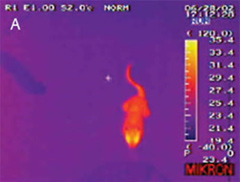 Squirrels communicate with rattlesnakes using heated tail Squirrels communicate with rattlesnakes using heated tail mongabay.com August 13, 2007 Ground squirrels heat their tails to defend their young against predatory rattlesnakes, reports a study published in the early online edition of Proceedings of the Natural Academy of Sciences (PNAS). While scientists have long known that ground […]
Squirrels communicate with rattlesnakes using heated tail Squirrels communicate with rattlesnakes using heated tail mongabay.com August 13, 2007 Ground squirrels heat their tails to defend their young against predatory rattlesnakes, reports a study published in the early online edition of Proceedings of the Natural Academy of Sciences (PNAS). While scientists have long known that ground […]
Pythons turn bones of prey into calcium
Pythons turn bones of prey into calcium Pythons turn bones of prey into calcium Society for Experimental Biology April 1, 2007 Burmese pythons don’t eat very often, but when they do they like to pig out, ingesting the whole of their prey. There’s very little waste as they are able to digest everything, apart from […]
Doctor performs kidney surgery on egg-eating snake
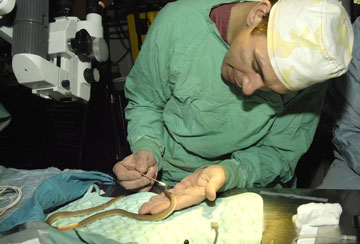 Doctor performs kidney surgery on egg-eating snake Doctor performs kidney surgery on egg-eating snake Pictures in the news mongabay.com February 22, 2007 In early February Dr. Robert Moore performed microsurgery on an adult African egg-eating snake at the Bronx Zoo’s Animal Health Center in New York. Snake surgery at the Bronx Zoo. Photos by Julie […]
Doctor performs kidney surgery on egg-eating snake Doctor performs kidney surgery on egg-eating snake Pictures in the news mongabay.com February 22, 2007 In early February Dr. Robert Moore performed microsurgery on an adult African egg-eating snake at the Bronx Zoo’s Animal Health Center in New York. Snake surgery at the Bronx Zoo. Photos by Julie […]
Blind pink snake discovered in Madagascar
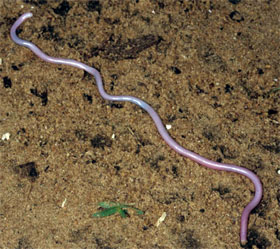 A pink worm-like snake has been rediscovered in Madagascar more than 100 years after it was first found. The snake, which is blind and measures about ten inches long, is described in the February 1, 2007 edition of Zootaxa, a leading taxonomic journal. The snake was captured during a 2005 expedition in the arid northern […]
A pink worm-like snake has been rediscovered in Madagascar more than 100 years after it was first found. The snake, which is blind and measures about ten inches long, is described in the February 1, 2007 edition of Zootaxa, a leading taxonomic journal. The snake was captured during a 2005 expedition in the arid northern […]
Snake becomes poisonous by eating toxic frogs
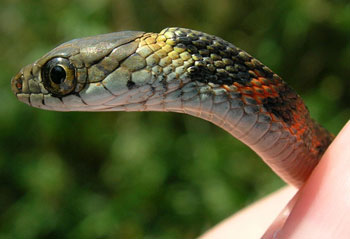 A new study shows that the Asian snake Rhabdophis tigrinus becomes poisonous by sequestering toxins from its prey which consists of toxic toads. The research is published in the current issue of The Proceedings of the National Academy of Sciences. Analyzing differences between snakes living on toad-rich and toad-deficient islands in Japan, Researchers lead by […]
A new study shows that the Asian snake Rhabdophis tigrinus becomes poisonous by sequestering toxins from its prey which consists of toxic toads. The research is published in the current issue of The Proceedings of the National Academy of Sciences. Analyzing differences between snakes living on toad-rich and toad-deficient islands in Japan, Researchers lead by […]
China uses snake-based earthquake prediction system
 A province in southern China has come up with a unique way to predict earthquakes: snakes. According to China Daily and as reported by Reuters, the earthquake bureau in Nanning, capital of the Guangxi province, has set up a 24-hour video feed to monitor the behavior of snakes at snake farms. The scientists say that […]
A province in southern China has come up with a unique way to predict earthquakes: snakes. According to China Daily and as reported by Reuters, the earthquake bureau in Nanning, capital of the Guangxi province, has set up a 24-hour video feed to monitor the behavior of snakes at snake farms. The scientists say that […]
The science behind ‘Snakes on a Plane’
 The science behind the movie “Snakes on a Plane” – how snakes see in the dark The science behind the movie “Snakes on a Plane” – how snakes see in the dark mongabay.com August 7, 2006 Even in the dark, snakes on a plane could keep a close watch on passengers and crew thanks to […]
The science behind the movie “Snakes on a Plane” – how snakes see in the dark The science behind the movie “Snakes on a Plane” – how snakes see in the dark mongabay.com August 7, 2006 Even in the dark, snakes on a plane could keep a close watch on passengers and crew thanks to […]
Venomous snakes key to human evolution says new theory
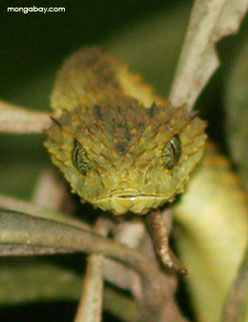 Venomous snakes key to human evolution says new theory Venomous snakes key to human evolution says new theory UC Davis July 21, 2006 The ability to spot venomous snakes may have played a major role in the evolution of monkeys, apes and humans, according to a new hypothesis by Lynne Isbell, professor of anthropology at […]
Venomous snakes key to human evolution says new theory Venomous snakes key to human evolution says new theory UC Davis July 21, 2006 The ability to spot venomous snakes may have played a major role in the evolution of monkeys, apes and humans, according to a new hypothesis by Lynne Isbell, professor of anthropology at […]
Color-changing chameleon snake discovered in jungles of Borneo
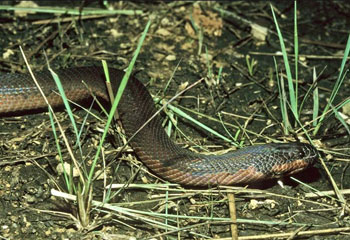 Color-changing chameleon snake discovered in jungles of Borneo Color-changing chameleon snake discovered in jungles of Borneo Rhett A. Butler, mongabay.com June 27, 2006 Scientists discovered a species of snake capable of changing colors. The snake, called the Kapuas mud snake, resides in the rainforest on the island of Borneo, an ecosystem that is increasingly threatened […]
Color-changing chameleon snake discovered in jungles of Borneo Color-changing chameleon snake discovered in jungles of Borneo Rhett A. Butler, mongabay.com June 27, 2006 Scientists discovered a species of snake capable of changing colors. The snake, called the Kapuas mud snake, resides in the rainforest on the island of Borneo, an ecosystem that is increasingly threatened […]
Python explodes after swallowing 6-foot alligator in Florida Everglades
 Fatal mistake: giant snakes eats alligator The National Park Service released photos that show the carcass of an American alligator that was almost swallowed by a Burmese python. Park officials discovered the animal carcasses in a remote part of Everglades National Park, in south Miami-Dade, Florida, on Monday, Sept. 26, 2005. It appears that the […]
Fatal mistake: giant snakes eats alligator The National Park Service released photos that show the carcass of an American alligator that was almost swallowed by a Burmese python. Park officials discovered the animal carcasses in a remote part of Everglades National Park, in south Miami-Dade, Florida, on Monday, Sept. 26, 2005. It appears that the […]
Feeds: news | india | latam | brasil | indonesia
 There is a longstanding disagreement amongst conservationists about whether or not it makes sense to focus efforts on protecting species that are popular with us Homo sapiens. Many argue that conserving the most imperiled species should be the priority, or that a species’ importance to the ecosystem in which it lives should be the decisive […]
There is a longstanding disagreement amongst conservationists about whether or not it makes sense to focus efforts on protecting species that are popular with us Homo sapiens. Many argue that conserving the most imperiled species should be the priority, or that a species’ importance to the ecosystem in which it lives should be the decisive […] Enchanted lakes and magic hills: how traditional stories support conservation and abundance “Long ago, when animals were gente…” Those words, uttered countless times by indigenous Amazonian storytellers, blur the boundary between humans and other creatures in the forests and rivers, revealing a different view of the way human and non-human worlds intertwine. “You can’t talk […]
Enchanted lakes and magic hills: how traditional stories support conservation and abundance “Long ago, when animals were gente…” Those words, uttered countless times by indigenous Amazonian storytellers, blur the boundary between humans and other creatures in the forests and rivers, revealing a different view of the way human and non-human worlds intertwine. “You can’t talk […] Trimeresurus gunaleni was previously lumped with other pit vipers, inhabits area that may contain more species yet-unknown to science A new pit viper was discovered by researchers working in Sumatra, Indonesia, and described in a new study in Amphibian & Reptile Conservation (amphibian-reptile-conservation.org). The reptile was identified by a group of chemists and herpetologists comprised […]
Trimeresurus gunaleni was previously lumped with other pit vipers, inhabits area that may contain more species yet-unknown to science A new pit viper was discovered by researchers working in Sumatra, Indonesia, and described in a new study in Amphibian & Reptile Conservation (amphibian-reptile-conservation.org). The reptile was identified by a group of chemists and herpetologists comprised […] A recent study examines the evolution of viper species in East Africa, highlighting the region’s mountaintop forests as among the most biodiverse in the world and calling for their protection. Atheris ceratophora enjoys a snack. Photo by Michele Menegon. East Africa is famous for its dry savannahs, sparse woodlands, and its “Big Five” animals: elephants, […]
A recent study examines the evolution of viper species in East Africa, highlighting the region’s mountaintop forests as among the most biodiverse in the world and calling for their protection. Atheris ceratophora enjoys a snack. Photo by Michele Menegon. East Africa is famous for its dry savannahs, sparse woodlands, and its “Big Five” animals: elephants, […] The slow loris may have evolved its venom as a mimic to deadly spectacled cobras A slow loris in a venom pose. Photo by: Andrew Walmsley. The bite of a slow loris can be painful, and sometimes even lethal. After all, this cute-looking YouTube sensation is the only known “venomous” primate in the world—a trait […]
The slow loris may have evolved its venom as a mimic to deadly spectacled cobras A slow loris in a venom pose. Photo by: Andrew Walmsley. The bite of a slow loris can be painful, and sometimes even lethal. After all, this cute-looking YouTube sensation is the only known “venomous” primate in the world—a trait […] Although not always very wide, roads can be huge barriers to wildlife. Not only do roads break up habitats, making animal movement more difficult, but they also allow people into long-inaccessible natural areas. A new study in mongabay.com’s open-access journal Tropical Conservation Science looks at how drivers on Brazil’s MG-010 road act when faced with […]
Although not always very wide, roads can be huge barriers to wildlife. Not only do roads break up habitats, making animal movement more difficult, but they also allow people into long-inaccessible natural areas. A new study in mongabay.com’s open-access journal Tropical Conservation Science looks at how drivers on Brazil’s MG-010 road act when faced with […] Newly hatched reticulated python (Malayopython reticulatus). These are one of the largest snakes in the world with the longest measuring 28 feet. Photo by: Julie Larsen Maher/WCS. Okay, so some snakes are so venomous they can kill you in 30 minutes (the inland taipan). And, yes, the fact that they don’t have legs is a […]
Newly hatched reticulated python (Malayopython reticulatus). These are one of the largest snakes in the world with the longest measuring 28 feet. Photo by: Julie Larsen Maher/WCS. Okay, so some snakes are so venomous they can kill you in 30 minutes (the inland taipan). And, yes, the fact that they don’t have legs is a […] New snake species: the Zoos Victoria wolf snake or Lycodon zoosvictoriae. Photo by Neang Thy/FFI. A new species of wolf snake has been discovered in the forests of the Cardamom Mountains of southeast Cambodia. The species is described in the current issue of the journal Zootaxa. Lycodon zoosvictoriae is named after Zoos Victoria, a conservation […]
New snake species: the Zoos Victoria wolf snake or Lycodon zoosvictoriae. Photo by Neang Thy/FFI. A new species of wolf snake has been discovered in the forests of the Cardamom Mountains of southeast Cambodia. The species is described in the current issue of the journal Zootaxa. Lycodon zoosvictoriae is named after Zoos Victoria, a conservation […] Chrysopelea Paradisi in flight. Photo by John J. Socha. Flying snakes achieve surprising amounts of lift through the shape of their bodies, report researchers from Virginia Tech in a paper recently published in the Journal of Experimental Biology. The study examined how paradise tree snakes—one of five species of so-called flying snake found in Southeast […]
Chrysopelea Paradisi in flight. Photo by John J. Socha. Flying snakes achieve surprising amounts of lift through the shape of their bodies, report researchers from Virginia Tech in a paper recently published in the Journal of Experimental Biology. The study examined how paradise tree snakes—one of five species of so-called flying snake found in Southeast […] Burmese Python dead after attempting to eat an alligator in Florida in 2005. The Burmese python is an invasive species in the Everglades where it causes widespread problems, including feasting on native animals. Photo by Michael Barron A security guard at a hotel in Bali was killed after he tried to catch a 13-foot-long (4m) […]
Burmese Python dead after attempting to eat an alligator in Florida in 2005. The Burmese python is an invasive species in the Everglades where it causes widespread problems, including feasting on native animals. Photo by Michael Barron A security guard at a hotel in Bali was killed after he tried to catch a 13-foot-long (4m) […] A fungal outbreak in the eastern and Midwestern United States is infecting some populations of wild snakes. Snake Fungal Disease (SFD), a fungal dermatitis consistently associated with the fungus Ophidiomyces ophiodiicola, is showing recent spikes in occurrence according to the U.S. Geological Survey’s National Wildlife Health Center (NWHC) and other diagnostic laboratories. So far, the […]
A fungal outbreak in the eastern and Midwestern United States is infecting some populations of wild snakes. Snake Fungal Disease (SFD), a fungal dermatitis consistently associated with the fungus Ophidiomyces ophiodiicola, is showing recent spikes in occurrence according to the U.S. Geological Survey’s National Wildlife Health Center (NWHC) and other diagnostic laboratories. So far, the […] In a world first, scientists have captured images and video of a boa constrictor attacking and devouring whole a femle howler monkey, one of the largest new world primates weighing in at around 4 kilograms (8.8 pounds). The rare predation event was recorded in a tiny forest fragment (2.5 hectares) in the Brazilian state of […]
In a world first, scientists have captured images and video of a boa constrictor attacking and devouring whole a femle howler monkey, one of the largest new world primates weighing in at around 4 kilograms (8.8 pounds). The rare predation event was recorded in a tiny forest fragment (2.5 hectares) in the Brazilian state of […] A male Bothriechis guifarroi, the newly discovered green palm-pitviper from Honduras. Photo credit: Josiah H. Townsend A stunning new species of pit-viper has been discovered in the cloud forest of Honduras. The venomous snake is described in the journal ZooKeys. The species is named Bothriechis guifarroi in honor of Mario Guifarro of Olancho, a conservationist […]
A male Bothriechis guifarroi, the newly discovered green palm-pitviper from Honduras. Photo credit: Josiah H. Townsend A stunning new species of pit-viper has been discovered in the cloud forest of Honduras. The venomous snake is described in the journal ZooKeys. The species is named Bothriechis guifarroi in honor of Mario Guifarro of Olancho, a conservationist […] Authorities in Vietnam arrested a man who they say was transporting 53 king cobras in his car, reports the Associated Press. The man said has was paid to transport the snakes, which are considered a delicacy by some in Vietnam and are sometimes used for traditional medicine. Police arrested the man and took the snakes […]
Authorities in Vietnam arrested a man who they say was transporting 53 king cobras in his car, reports the Associated Press. The man said has was paid to transport the snakes, which are considered a delicacy by some in Vietnam and are sometimes used for traditional medicine. Police arrested the man and took the snakes […] Green iguana in Colombia. Photo by Rhett A. Butler Nearly a fifth the planet’s reptiles are threatened with extinction, warns a new assessment published in the journal Biological Conservation. The analysis, carried out by experts with the Zoological Society of London (ZSL) and the IUCN Species Survival Commission (SSC), is based on the extinction risk […]
Green iguana in Colombia. Photo by Rhett A. Butler Nearly a fifth the planet’s reptiles are threatened with extinction, warns a new assessment published in the journal Biological Conservation. The analysis, carried out by experts with the Zoological Society of London (ZSL) and the IUCN Species Survival Commission (SSC), is based on the extinction risk […] Sunday, February 10, marks start of Chinese New Year. 2013 is the “Year of the Snake” — specifically the water snake. The last Year of the Snake ran from January 23, 2001 to February 11, 2002. The last Year of the Water Snake took place from February 14, 1953 to February 2, 1954. The Year […]
Sunday, February 10, marks start of Chinese New Year. 2013 is the “Year of the Snake” — specifically the water snake. The last Year of the Snake ran from January 23, 2001 to February 11, 2002. The last Year of the Water Snake took place from February 14, 1953 to February 2, 1954. The Year […] Spotted hyena in the Masai Mara. Photo by: Rhett A. Butler. Animals of the Masai Mara is the first illustrated guidebook to the Masai Mara region along the Kenya and Tanzania border. This is the world famous region of wildebeest migrations, large felines, towering African elephants, fascinating cultures, and great flora and fauna diversity. This […]
Spotted hyena in the Masai Mara. Photo by: Rhett A. Butler. Animals of the Masai Mara is the first illustrated guidebook to the Masai Mara region along the Kenya and Tanzania border. This is the world famous region of wildebeest migrations, large felines, towering African elephants, fascinating cultures, and great flora and fauna diversity. This […] The Ruby-eyed pit viper (Trimeresurus rubeus) was discovered in the forest of Vietnam’s Cat Tien national park. Photograph: Peter Paul van Dijk/Darwin Initiative. Some 126 new species were described in Asia’a Mekong region last year, notes a new report published by the World Wildlife Fund (WWF). Extra Terrestrial — a follow up to last year’s […]
The Ruby-eyed pit viper (Trimeresurus rubeus) was discovered in the forest of Vietnam’s Cat Tien national park. Photograph: Peter Paul van Dijk/Darwin Initiative. Some 126 new species were described in Asia’a Mekong region last year, notes a new report published by the World Wildlife Fund (WWF). Extra Terrestrial — a follow up to last year’s […] The reticulated python. Photo by Rhett Butler. Bird conservationists in the United States are urging Congress to ban imports of five types of snakes that are considered a threat to native birds. In a letter sent the U.S. House Resource Committee, the American Bird Conservancy called for a ban on imports and inter-state trade in […]
The reticulated python. Photo by Rhett Butler. Bird conservationists in the United States are urging Congress to ban imports of five types of snakes that are considered a threat to native birds. In a letter sent the U.S. House Resource Committee, the American Bird Conservancy called for a ban on imports and inter-state trade in […] A live Imantodes chocoensis. Its head is about the size of an American penny. Photo by: Omar Torres-Carvajal et al. There’s no question that blunt-headed vine snakes are an odd lot: a thin body tapers into an even thinner neck which expands suddenly into a broad head with massive eyes. Until now only six species […]
A live Imantodes chocoensis. Its head is about the size of an American penny. Photo by: Omar Torres-Carvajal et al. There’s no question that blunt-headed vine snakes are an odd lot: a thin body tapers into an even thinner neck which expands suddenly into a broad head with massive eyes. Until now only six species […] Illegally traded lizards (left to right): black tree monitor (Varanus beccarii), Reisinger’s tree monitor (Varanus reisingeri), emerald monitor (Varanus prasinus), and the blue-spotted tree monitor (Varanus macraei). Photo courtesy of Jessica Lyons. Demand for exotic pets is driving the illegal harvest and trade of herpetofauna (reptiles and amphibians) in Indonesian New Guinea, according to a […]
Illegally traded lizards (left to right): black tree monitor (Varanus beccarii), Reisinger’s tree monitor (Varanus reisingeri), emerald monitor (Varanus prasinus), and the blue-spotted tree monitor (Varanus macraei). Photo courtesy of Jessica Lyons. Demand for exotic pets is driving the illegal harvest and trade of herpetofauna (reptiles and amphibians) in Indonesian New Guinea, according to a […] New snail-eating snake from Panama: Sibon noalamina. Non-venomous snail-eating snakes sport bright colors to mimic poisonous snakes as a defense. Photo © Sebastian Lotzkat. While scientists increasingly name new species after celebrities in order to gain much-needed attention for the world’s vanishing biodiversity, researchers describing a new snake species from Panama have taken a different […]
New snail-eating snake from Panama: Sibon noalamina. Non-venomous snail-eating snakes sport bright colors to mimic poisonous snakes as a defense. Photo © Sebastian Lotzkat. While scientists increasingly name new species after celebrities in order to gain much-needed attention for the world’s vanishing biodiversity, researchers describing a new snake species from Panama have taken a different […] The accidental introduction of the brown tree snake on Guam has resulted in a loss of birds and a subsequent explosion of spiders. Photo by: Isaac Chellman. The island of Guam is drowning in spiders. New research in the open-access journal PLOS ONE has found that in the wet season, Guam’s arachnid population booms to […]
The accidental introduction of the brown tree snake on Guam has resulted in a loss of birds and a subsequent explosion of spiders. Photo by: Isaac Chellman. The island of Guam is drowning in spiders. New research in the open-access journal PLOS ONE has found that in the wet season, Guam’s arachnid population booms to […] A female blue crowned manakin (Lepidothrix coronata) is one of over a thousand known bird species in Madidi National Park. Photo by: Mileniusz Spanowicz/WCS. With over 90 species of bat, 50 species of snake, 300 fish, 12,000 plants, and 11 percent of the world’s bird species, Madidi National Park in Bolivia may be the world’s […]
A female blue crowned manakin (Lepidothrix coronata) is one of over a thousand known bird species in Madidi National Park. Photo by: Mileniusz Spanowicz/WCS. With over 90 species of bat, 50 species of snake, 300 fish, 12,000 plants, and 11 percent of the world’s bird species, Madidi National Park in Bolivia may be the world’s […] On Aug. 10, 2012, researchers at the Florida Museum of Natural History on the University of Florida campus examine the internal anatomy of the largest Burmese python found in Florida to date. The 17-foot-7-inch snake weighed 164 pounds and carried 87 eggs in its oviducts, a state record. Following scientific investigation, the snake will be […]
On Aug. 10, 2012, researchers at the Florida Museum of Natural History on the University of Florida campus examine the internal anatomy of the largest Burmese python found in Florida to date. The 17-foot-7-inch snake weighed 164 pounds and carried 87 eggs in its oviducts, a state record. Following scientific investigation, the snake will be […] New species: the Cambodian kukri. Photo by: Photo: Neang Thy/FFI. Scientists have discovered a new snake species in the biodiverse rainforests of the Cardamom Mountains, reports Fauna & Flora International (FFI). The new reddish-hued serpent has been named after its country of origin by native herpetologist Neang Thy: the Cambodian kukri (Oligodon kampucheaensis). “Cambodian science […]
New species: the Cambodian kukri. Photo by: Photo: Neang Thy/FFI. Scientists have discovered a new snake species in the biodiverse rainforests of the Cardamom Mountains, reports Fauna & Flora International (FFI). The new reddish-hued serpent has been named after its country of origin by native herpetologist Neang Thy: the Cambodian kukri (Oligodon kampucheaensis). “Cambodian science […]-(Large).568.jpg) World’s rarest snake: Saint Lucia racer. Photo by: G. Guida. It’s slithery, brown, and doesn’t mind being picked up: meet the Saint Lucia racer (Liophis ornatus), which holds the dubious honor of being the world’s most endangered snake. A five month extensive survey found just 18 animals on a small islet off of the Caribbean […]
World’s rarest snake: Saint Lucia racer. Photo by: G. Guida. It’s slithery, brown, and doesn’t mind being picked up: meet the Saint Lucia racer (Liophis ornatus), which holds the dubious honor of being the world’s most endangered snake. A five month extensive survey found just 18 animals on a small islet off of the Caribbean […] The IUCN Red List releases its 2012 update, adding 247 species to its threatened categories. The king cobra has been evaluated by the IUCN Red List for the first time and listed as Vulnerable. Photo by: Rhett A. Butler. Nearly 250 species have been added to the threatened categories—i.e. Vulnerable, Endangered, and Critically Endangered—in this […]
The IUCN Red List releases its 2012 update, adding 247 species to its threatened categories. The king cobra has been evaluated by the IUCN Red List for the first time and listed as Vulnerable. Photo by: Rhett A. Butler. Nearly 250 species have been added to the threatened categories—i.e. Vulnerable, Endangered, and Critically Endangered—in this […] Giant Palm Footed Salamander (Bolitoglossa dofleini). Photo by Robin Moore/robindmoore.com. Fifteen conservation groups have banded together to save around 2,400 hectares (6,000 acres) of primary rainforest in Guatemala, home to a dozen imperiled amphibians as well as the recently discovered Merendon palm pit viper (Bothriechis thalassinus). The new park, dubbed the Sierra Caral Amphibian Reserve, […]
Giant Palm Footed Salamander (Bolitoglossa dofleini). Photo by Robin Moore/robindmoore.com. Fifteen conservation groups have banded together to save around 2,400 hectares (6,000 acres) of primary rainforest in Guatemala, home to a dozen imperiled amphibians as well as the recently discovered Merendon palm pit viper (Bothriechis thalassinus). The new park, dubbed the Sierra Caral Amphibian Reserve, […] Scientists in Australia have discovered a species of sea snake in estuaries of the Gulf of Carpenteria in northern Australia. The snake is described in the current issue of Zootaxa. The species, dubbed Hydrophis donaldii after the discover’s boat captain David Donald, is distinguished from other related sea snakes by its “raised” scales. Its common […]
Scientists in Australia have discovered a species of sea snake in estuaries of the Gulf of Carpenteria in northern Australia. The snake is described in the current issue of Zootaxa. The species, dubbed Hydrophis donaldii after the discover’s boat captain David Donald, is distinguished from other related sea snakes by its “raised” scales. Its common […] Malaysia failed to effectively assemble a case against convicted wildlife smuggler Anson Wong, leading to his early release from prison, says an anti-wildlife trafficking group. Wong was released yesterday after serving under a third of his his five-year prison term for wildlife trafficking. Wong was arrested in 2010 after a luggage malfunction led Malaysia Airlines […]
Malaysia failed to effectively assemble a case against convicted wildlife smuggler Anson Wong, leading to his early release from prison, says an anti-wildlife trafficking group. Wong was released yesterday after serving under a third of his his five-year prison term for wildlife trafficking. Wong was arrested in 2010 after a luggage malfunction led Malaysia Airlines […] Notorious wildlife trafficker Anson Wong has been freed from prison after a court reduced his five-year term, reports Malaysian state media. Wong had served 17-and-a-half-months for illegally exporting nearly 100 reptiles from Malaysia. Wong was arrested in 2010 after a luggage malfunction led Malaysia Airlines security staff revealed he was illegally carrying 95 boa constrictors, […]
Notorious wildlife trafficker Anson Wong has been freed from prison after a court reduced his five-year term, reports Malaysian state media. Wong had served 17-and-a-half-months for illegally exporting nearly 100 reptiles from Malaysia. Wong was arrested in 2010 after a luggage malfunction led Malaysia Airlines security staff revealed he was illegally carrying 95 boa constrictors, […] An American alligator and a Burmese python struggle in Everglades National Park. Photo by: Lori Oberhofer, U.S. National Park Service. The Everglades in southern Florida has faced myriad environmental impacts from draining for sprawl to the construction of canals, but even as the U.S. government moves slowly on an ambitious plan to restore the massive […]
An American alligator and a Burmese python struggle in Everglades National Park. Photo by: Lori Oberhofer, U.S. National Park Service. The Everglades in southern Florida has faced myriad environmental impacts from draining for sprawl to the construction of canals, but even as the U.S. government moves slowly on an ambitious plan to restore the massive […] An American alligator and a Burmese python struggle in Everglades National Park. Photo by: Lori Oberhofer, U.S. National Park Service. Last week the U.S. Fish and Wildlife Service (USFWS) announced it was banning the importation and sale across state lines of four large, non-native snakes: the Burmese python (Python molurus bivittatus), the yellow anaconda (Eunectes […]
An American alligator and a Burmese python struggle in Everglades National Park. Photo by: Lori Oberhofer, U.S. National Park Service. Last week the U.S. Fish and Wildlife Service (USFWS) announced it was banning the importation and sale across state lines of four large, non-native snakes: the Burmese python (Python molurus bivittatus), the yellow anaconda (Eunectes […] The Alangyi coastline. Photo by: Pierre Fidenci. Voters in the January 14 Taiwanese presidential election will decide the fate of the island’s last pristine wilderness known as the Alangyi Trail. Amongst the three candidates, only one (Tsai Ing-wen from the Democratic Progressive Party) may support the conservation of Alangyi Trail and its coastline. One of […]
The Alangyi coastline. Photo by: Pierre Fidenci. Voters in the January 14 Taiwanese presidential election will decide the fate of the island’s last pristine wilderness known as the Alangyi Trail. Amongst the three candidates, only one (Tsai Ing-wen from the Democratic Progressive Party) may support the conservation of Alangyi Trail and its coastline. One of […] This interview is an excerpt from The WildLife with Laurel Neme, a program that explores the mysteries of the animal world through interviews with scientists and other wildlife investigators. “The WildLife” airs every Monday from 1-2 pm EST on WOMM-LP, 105.9 FM in Burlington, Vermont. You can livestream it at theradiator.org or download the podcast […]
This interview is an excerpt from The WildLife with Laurel Neme, a program that explores the mysteries of the animal world through interviews with scientists and other wildlife investigators. “The WildLife” airs every Monday from 1-2 pm EST on WOMM-LP, 105.9 FM in Burlington, Vermont. You can livestream it at theradiator.org or download the podcast […] This interview is an excerpt from The WildLife with Laurel Neme, a program that explores the mysteries of the animal world through interviews with scientists and other wildlife investigators. “The WildLife” airs every Monday from 1-2 pm EST on WOMM-LP, 105.9 FM in Burlington, Vermont. You can livestream it at theradiator.org or download the podcast […]
This interview is an excerpt from The WildLife with Laurel Neme, a program that explores the mysteries of the animal world through interviews with scientists and other wildlife investigators. “The WildLife” airs every Monday from 1-2 pm EST on WOMM-LP, 105.9 FM in Burlington, Vermont. You can livestream it at theradiator.org or download the podcast […] Matilda’s horned viper. Photo by: Tim Davenport. In a remote forest fragment in Tanzania, scientists have made a remarkable discovery: a uniquely-colored horned viper extending over two feet long (643 millimeters) that evolved from its closest relative over two million years ago. Unfortunately, however, the new species—named Matilda’s horned viper (Atheris matildae)—survives in a small […]
Matilda’s horned viper. Photo by: Tim Davenport. In a remote forest fragment in Tanzania, scientists have made a remarkable discovery: a uniquely-colored horned viper extending over two feet long (643 millimeters) that evolved from its closest relative over two million years ago. Unfortunately, however, the new species—named Matilda’s horned viper (Atheris matildae)—survives in a small […] Skin of female python killed by Agta Negrito men. Photo by: J. Headland. Humans have an ambivalent relationship with snakes. The legless reptiles are often feared and reviled, becoming stand-ins for the Devil and movie monster characters; yet many people have grown to love snakes, raising large, even dangerous, specimens as pets. Now, new research […]
Skin of female python killed by Agta Negrito men. Photo by: J. Headland. Humans have an ambivalent relationship with snakes. The legless reptiles are often feared and reviled, becoming stand-ins for the Devil and movie monster characters; yet many people have grown to love snakes, raising large, even dangerous, specimens as pets. Now, new research […] Rainbow snake, of which the South Florida rainbow snake is a subspecies. Photo by: Alan Garrett. Need to make a quick 500 bucks? Easy: head to Glades County, Florida and find a specimen of the South Florida rainbow snake (Farancia erytrogramma seminola), which the US government says is extinct. In an unusual bid two NGOS, […]
Rainbow snake, of which the South Florida rainbow snake is a subspecies. Photo by: Alan Garrett. Need to make a quick 500 bucks? Easy: head to Glades County, Florida and find a specimen of the South Florida rainbow snake (Farancia erytrogramma seminola), which the US government says is extinct. In an unusual bid two NGOS, […] Often lauded as a model for conserving wild populations, breeding centers in Indonesia are shown to be actually worsening depletion of wildlife. Green tree python Breeding farms in Indonesia are being used to launder illegally caught wildlife, finds a new study published in the journal Biological Conservation. The research is based on surveys of traders […]
Often lauded as a model for conserving wild populations, breeding centers in Indonesia are shown to be actually worsening depletion of wildlife. Green tree python Breeding farms in Indonesia are being used to launder illegally caught wildlife, finds a new study published in the journal Biological Conservation. The research is based on surveys of traders […] Everyone loves the beautiful animals, the playful orangutans, the rolly-polly pandas, the regal tigers, the wise elephants, the awe-inspiring whales, the silly penguins—and it shows. Aside from gracing calendars and starring in movies, these species receive millions in conservation funds and have no shortage of researchers devoted to them. But what about the ugly, crawly, […]
Everyone loves the beautiful animals, the playful orangutans, the rolly-polly pandas, the regal tigers, the wise elephants, the awe-inspiring whales, the silly penguins—and it shows. Aside from gracing calendars and starring in movies, these species receive millions in conservation funds and have no shortage of researchers devoted to them. But what about the ugly, crawly, […] Brown-headed parrot (Poicephalus cryptoxanthus) fledgling in tree cavity in Botswana. Photo by: Tiffany Roufs. Aged, living trees are essential for over 1,000 birds and mammals that depend on such trees for nesting holes, according to a study in Frontiers in Ecology and the Environment. In much of the world, tree-nesting animals depend on holes formed […]
Brown-headed parrot (Poicephalus cryptoxanthus) fledgling in tree cavity in Botswana. Photo by: Tiffany Roufs. Aged, living trees are essential for over 1,000 birds and mammals that depend on such trees for nesting holes, according to a study in Frontiers in Ecology and the Environment. In much of the world, tree-nesting animals depend on holes formed […] Salmon-bellied snake . Photo by: Rhett A. Butler. The salmon-bellied snake (Mastigodryas melanolomus) is found in Central American forests, savannas, and even agricultural areas. It preys on lizards, frogs, and rodents. Described as ‘very adaptable’ by the IUCN Red List the snake is listed as Least Concern. For more photos of snakes in Costa Rica […]
Salmon-bellied snake . Photo by: Rhett A. Butler. The salmon-bellied snake (Mastigodryas melanolomus) is found in Central American forests, savannas, and even agricultural areas. It preys on lizards, frogs, and rodents. Described as ‘very adaptable’ by the IUCN Red List the snake is listed as Least Concern. For more photos of snakes in Costa Rica […] The US Fish and Wildlife Service announced yesterday that the believe two species in Florida have vanished into the long dark night: the South Florida rainbow snake (Farancia erytrogramma seminola) and the Florida fairy shrimp (Dexteria floridana). The species were under review for possibly being added to the Endangered Species Act (ESA), but it’s likely […]
The US Fish and Wildlife Service announced yesterday that the believe two species in Florida have vanished into the long dark night: the South Florida rainbow snake (Farancia erytrogramma seminola) and the Florida fairy shrimp (Dexteria floridana). The species were under review for possibly being added to the Endangered Species Act (ESA), but it’s likely […] Fer de lances are ‘milked’ in order to extract the venom to create anti-venom. This photo was taken in Amacayacu National Park in Colombia. Photo by: Rhett A. Butler. If you’re unfortunate enough to be bit by a venomous snake in South America, its most likely the fer-de-lance (Bothrops atrox). Found in both forests and […]
Fer de lances are ‘milked’ in order to extract the venom to create anti-venom. This photo was taken in Amacayacu National Park in Colombia. Photo by: Rhett A. Butler. If you’re unfortunate enough to be bit by a venomous snake in South America, its most likely the fer-de-lance (Bothrops atrox). Found in both forests and […] The missing Bronx Zoo cobra has been recaptured. Photo by Julie Larsen Maher of WCS. The missing Bronx Zoo cobra that became a pop culture sensation and caused consternation among some New York residents whas been found after a thorough search of the zoo’s Reptile House. The escaped serpent was found in a non-public, off-exhibit […]
The missing Bronx Zoo cobra has been recaptured. Photo by Julie Larsen Maher of WCS. The missing Bronx Zoo cobra that became a pop culture sensation and caused consternation among some New York residents whas been found after a thorough search of the zoo’s Reptile House. The escaped serpent was found in a non-public, off-exhibit […] Hard to miss the bright red ruby eyes of the world’s newest pitviper: Cryptelytrops rubeus. Photo ©: Peter Paul van Dijk. Researchers have discovered two new species of pitviper in Southeast Asia. After collecting snakes throughout the Asian tropics—Thailand, Laos, Vietnam, and Cambodia—researchers were able to parse out a more complex set of species than […]
Hard to miss the bright red ruby eyes of the world’s newest pitviper: Cryptelytrops rubeus. Photo ©: Peter Paul van Dijk. Researchers have discovered two new species of pitviper in Southeast Asia. After collecting snakes throughout the Asian tropics—Thailand, Laos, Vietnam, and Cambodia—researchers were able to parse out a more complex set of species than […] Dengan usaha yang sangat kreatif untuk menyingkirkan spesies agresif, Departemen Pertanian AS merencanakan untuk menjatuhkan ‘bom’ di hutan hujan pulau Guam dengan tikus beku mati yang dilapisi acetaminophen. Bom-tikus ini ditargetkan pada ular pohon cokelat, spesies penyerang yang telah membinasakan kehidupan alam setempat, dan membuat marah penduduk setempat, sejak muncul di tahun 1940-an. Idenya adalah […]
Dengan usaha yang sangat kreatif untuk menyingkirkan spesies agresif, Departemen Pertanian AS merencanakan untuk menjatuhkan ‘bom’ di hutan hujan pulau Guam dengan tikus beku mati yang dilapisi acetaminophen. Bom-tikus ini ditargetkan pada ular pohon cokelat, spesies penyerang yang telah membinasakan kehidupan alam setempat, dan membuat marah penduduk setempat, sejak muncul di tahun 1940-an. Idenya adalah […] A Malaysian court sentenced notorious wildlife trafficker Anson Wong to five years in jail, reports The Star. Justice Mohtarudin Baki ruled for the longer sentence after an appeal by the Attorney-General’s Chambers. Wong is expected to appeal. The judge also ordered the 190,000 Malaysian ringgit ($61,000) fine imposed on Wong to be returned to him. […]
A Malaysian court sentenced notorious wildlife trafficker Anson Wong to five years in jail, reports The Star. Justice Mohtarudin Baki ruled for the longer sentence after an appeal by the Attorney-General’s Chambers. Wong is expected to appeal. The judge also ordered the 190,000 Malaysian ringgit ($61,000) fine imposed on Wong to be returned to him. […] Researchers have discovered a biological shocker: female boa constrictors are capable of giving birth asexually. But the surprise doesn’t end there. The study in Biology Letters found that boa babies produced through this asexual reproduction—also known as parthenogenesis—sport a chromosomal oddity that researchers thought was impossible in reptiles. While researchers admit that the female in […]
Researchers have discovered a biological shocker: female boa constrictors are capable of giving birth asexually. But the surprise doesn’t end there. The study in Biology Letters found that boa babies produced through this asexual reproduction—also known as parthenogenesis—sport a chromosomal oddity that researchers thought was impossible in reptiles. While researchers admit that the female in […] The Antiguan racer (Alsophis antiguae) shares a similar story with many highly endangered island species. Invasive mongoose killed every racer on the Caribbean island of Antigua, leaving only a small population on nearby Great Bird Island. Confined to 8 hectares, this final population was being killed-off by invasive Eurasian black rats. By the time conservationists […]
The Antiguan racer (Alsophis antiguae) shares a similar story with many highly endangered island species. Invasive mongoose killed every racer on the Caribbean island of Antigua, leaving only a small population on nearby Great Bird Island. Confined to 8 hectares, this final population was being killed-off by invasive Eurasian black rats. By the time conservationists […] A look back at species discovered over the last decade in the Amazon. A new report by the World Wide Fund for Nature (WWF) confirms the Amazon rainforest, even as it is shrinking due to deforestation, remains among the world’s most surprising places. According to the report, Amazon Alive, over the past decade (1999-2009) researchers […]
A look back at species discovered over the last decade in the Amazon. A new report by the World Wide Fund for Nature (WWF) confirms the Amazon rainforest, even as it is shrinking due to deforestation, remains among the world’s most surprising places. According to the report, Amazon Alive, over the past decade (1999-2009) researchers […] Wildlife smuggler Anson Wong and his wife Cheah Bing Shee had their business licenses and wildlife permits revoked after the notorious trafficker was convicted of attempting to illegally take nearly 100 snakes out of Malaysia, reports The Star. The Natural Resources and Environment Ministry said the National Wildlife and Parks Department (Perhilitan) intends to confiscate […]
Wildlife smuggler Anson Wong and his wife Cheah Bing Shee had their business licenses and wildlife permits revoked after the notorious trafficker was convicted of attempting to illegally take nearly 100 snakes out of Malaysia, reports The Star. The Natural Resources and Environment Ministry said the National Wildlife and Parks Department (Perhilitan) intends to confiscate […] In a spectacularly creative effort to rid Guam of an invasive species, the US Department of Agriculture is planning to ‘bomb’ the island’s rainforests with dead frozen mice laced with acetaminophen. The mice-bombs are meant to target the brown tree snake, an invasive species which has ravaged local wildlife, and angered local residents, since arriving […]
In a spectacularly creative effort to rid Guam of an invasive species, the US Department of Agriculture is planning to ‘bomb’ the island’s rainforests with dead frozen mice laced with acetaminophen. The mice-bombs are meant to target the brown tree snake, an invasive species which has ravaged local wildlife, and angered local residents, since arriving […] Why biodiversity matters for carbon storage Notorious wildlife trafficker Anson Wong has been fined 190,000 Malaysian ringgit ($61,000) and sentenced to 6 months in jail for attempting to smuggle 95 boa constrictors, reports the Malaysian Star. Anson Wong, made famous in The Lizard King, a book by Bryan Christy that exposed his trafficking activities, was […]
Why biodiversity matters for carbon storage Notorious wildlife trafficker Anson Wong has been fined 190,000 Malaysian ringgit ($61,000) and sentenced to 6 months in jail for attempting to smuggle 95 boa constrictors, reports the Malaysian Star. Anson Wong, made famous in The Lizard King, a book by Bryan Christy that exposed his trafficking activities, was […] A notorious reptile smuggler has been busted at Malaysia Kuala Lumpur International Airport after his luggage was found to contain 98 snakes and a turtle, reports the Malaysian Star. Anson Wong, made famous in The Lizard King, a book by Bryan Christy that exposed his trafficking activities, was taken into custody by police after being […]
A notorious reptile smuggler has been busted at Malaysia Kuala Lumpur International Airport after his luggage was found to contain 98 snakes and a turtle, reports the Malaysian Star. Anson Wong, made famous in The Lizard King, a book by Bryan Christy that exposed his trafficking activities, was taken into custody by police after being […] A number of reports over the last decade have shown amphibians, lizards, fish, and birds facing steep population declines across species and continents, providing further evidence that the planet is undergoing a mass extinction. Now a new study in Biology Letters adds another group of animals to that list: snakes. Studying 17 snake populations from […]
A number of reports over the last decade have shown amphibians, lizards, fish, and birds facing steep population declines across species and continents, providing further evidence that the planet is undergoing a mass extinction. Now a new study in Biology Letters adds another group of animals to that list: snakes. Studying 17 snake populations from […] World-traveling blindsnake points to Madagascar’s origins and great voyages across the Atlantic. Call them survivors: blindsnakes have been identified as one of the few groups of organisms that inhabited Madagascar when it broke from the Indian subcontinent around 100 million years ago. According to a new study in Biology Letters, blindsnakes not only survived the […]
World-traveling blindsnake points to Madagascar’s origins and great voyages across the Atlantic. Call them survivors: blindsnakes have been identified as one of the few groups of organisms that inhabited Madagascar when it broke from the Indian subcontinent around 100 million years ago. According to a new study in Biology Letters, blindsnakes not only survived the […] Paul Rosolie leads volunteer expeditions into the Peruvian rainforest with an aim towards education and grassroots conservation. Mongabay.com’s eighth in its series of interviews with ‘Young Scientists’. At twenty-two Paul Rosolie has seen more adventure than many of us will in our lifetime. First visiting the Amazon at eighteen, Rosolie has explored strange jungle ecosystems, […]
Paul Rosolie leads volunteer expeditions into the Peruvian rainforest with an aim towards education and grassroots conservation. Mongabay.com’s eighth in its series of interviews with ‘Young Scientists’. At twenty-two Paul Rosolie has seen more adventure than many of us will in our lifetime. First visiting the Amazon at eighteen, Rosolie has explored strange jungle ecosystems, […] Sauropod babies for breakfast A fossilized snake has been discovered inside a titanosaur nest in India, leading researchers to conclude that the snake fed on newly-hatched dinosaur babies, rather than their eggs like modern snakes. Paleontologist and snake expert Jason Head says that the snake, known as Sanajeh indicus, lacked the wipe-jaws needed to swallow […]
Sauropod babies for breakfast A fossilized snake has been discovered inside a titanosaur nest in India, leading researchers to conclude that the snake fed on newly-hatched dinosaur babies, rather than their eggs like modern snakes. Paleontologist and snake expert Jason Head says that the snake, known as Sanajeh indicus, lacked the wipe-jaws needed to swallow […] Members with the conservation group Lion Guardians stumbled on a rare site in the Amboseli area of Kenya recently: six hyenas and a number of jackals were attacking and eating a 12-foot-long python. On their blog at WildlifeDirect, Lion Guardians describe the attack: “[the hyenas and jackals] tore into its body from the back, and […]
Members with the conservation group Lion Guardians stumbled on a rare site in the Amboseli area of Kenya recently: six hyenas and a number of jackals were attacking and eating a 12-foot-long python. On their blog at WildlifeDirect, Lion Guardians describe the attack: “[the hyenas and jackals] tore into its body from the back, and […] Playful giant river otters, massive anacondas, unafraid tapirs, and the world’s largest spider recorded in Guyana’s lost world. An expedition deep into Guyana’s rainforest interior to find the endangered giant river otter—and collect their scat for genetic analysis—uncovered much more than even this endangered charismatic species. “Visiting the Rewa Head felt like we were walking […]
Playful giant river otters, massive anacondas, unafraid tapirs, and the world’s largest spider recorded in Guyana’s lost world. An expedition deep into Guyana’s rainforest interior to find the endangered giant river otter—and collect their scat for genetic analysis—uncovered much more than even this endangered charismatic species. “Visiting the Rewa Head felt like we were walking […] A new invasive python in Florida may be worse than the species already causing ecological havoc across the Everglades, reports the Miami Herald. A recent string of captures of African rock pythons has authorities worried that the species, smaller but much more aggressive than the already-established Burmese python, is getting a foothold in the state. […]
A new invasive python in Florida may be worse than the species already causing ecological havoc across the Everglades, reports the Miami Herald. A recent string of captures of African rock pythons has authorities worried that the species, smaller but much more aggressive than the already-established Burmese python, is getting a foothold in the state. […] Florida has authorized a cull of Burmese pythons that have invaded the Everglades and other wetland areas, reports the Associated Press. A spokeswoman for the Florida Fish and Wildlife Conservation Commission, Pat Behnke, said ten snake-hunters would be dispatched to capture and euthanize Burmese pythons two weeks after the death of a toddler in her […]
Florida has authorized a cull of Burmese pythons that have invaded the Everglades and other wetland areas, reports the Associated Press. A spokeswoman for the Florida Fish and Wildlife Conservation Commission, Pat Behnke, said ten snake-hunters would be dispatched to capture and euthanize Burmese pythons two weeks after the death of a toddler in her […]


 Photos: Rare rhino rat snake hatches in London zoo Rare rhino rat snake hatches in London zoo Jeremy Hance, mongabay.com November 13, 2008
Photos: Rare rhino rat snake hatches in London zoo Rare rhino rat snake hatches in London zoo Jeremy Hance, mongabay.com November 13, 2008 Photos of the world’s smallest snake species Photo: Scientists discover world’s smallest snake species Jeremy Hance, mongabay.com August 3, 2008 If one wanted to overcome their fear of snakes, they may want to start with the newly discovered Leptotyphlops carlae. Measuring less than four inches long, even stretched out this new species of threadsnake can’t […]
Photos of the world’s smallest snake species Photo: Scientists discover world’s smallest snake species Jeremy Hance, mongabay.com August 3, 2008 If one wanted to overcome their fear of snakes, they may want to start with the newly discovered Leptotyphlops carlae. Measuring less than four inches long, even stretched out this new species of threadsnake can’t […] An official with Brazil’s environmental protection agency Ibama claims that snakes are invading the city of Belem due to deforestation of the Amazon rainforest. Interviewed by the Associated Press, Ibama press officer Luciana Almeida said the agency has been called out to capture 21 snakes this year in the Amazonian city of 1.5 million. She […]
An official with Brazil’s environmental protection agency Ibama claims that snakes are invading the city of Belem due to deforestation of the Amazon rainforest. Interviewed by the Associated Press, Ibama press officer Luciana Almeida said the agency has been called out to capture 21 snakes this year in the Amazonian city of 1.5 million. She […] Photos: world’s largest spitting cobra discovered in Kenya Photos: world’s largest spitting cobra discovered in Kenya Rhett A. Butler, mongabay.com December 9, 2007 The world’s largest spitting cobra has been discovered in Kenya, according to WildlifeDirect, a conservation group. Picture by Anton Childs Picture by Bonnie Sare Picture by Royjan Taylor Picture by Bonnie Sare […]
Photos: world’s largest spitting cobra discovered in Kenya Photos: world’s largest spitting cobra discovered in Kenya Rhett A. Butler, mongabay.com December 9, 2007 The world’s largest spitting cobra has been discovered in Kenya, according to WildlifeDirect, a conservation group. Picture by Anton Childs Picture by Bonnie Sare Picture by Royjan Taylor Picture by Bonnie Sare […] Snake uses trick to avoid poisoning from toxic frogs Snake uses trick to avoid poisoning from toxic frogs mongabay.com October 16, 2007 An Australian snake employs a special feeding behavior to avoid poisoning by toxic frogs, reports The American Naturalist. University of Sydney scientists Ben Phillips and Richards Shine found that the northern death adder […]
Snake uses trick to avoid poisoning from toxic frogs Snake uses trick to avoid poisoning from toxic frogs mongabay.com October 16, 2007 An Australian snake employs a special feeding behavior to avoid poisoning by toxic frogs, reports The American Naturalist. University of Sydney scientists Ben Phillips and Richards Shine found that the northern death adder […] How do snakes survive starvation? How do snakes survive starvation? University of Arkansas, Fayetteville August 27, 2007 Starving snakes employ novel survival strategies not seen before in vertebrates, according to research conducted by a University of Arkansas biologist. These findings could be used in conservation strategies to determine the health of snake populations. “These animals […]
How do snakes survive starvation? How do snakes survive starvation? University of Arkansas, Fayetteville August 27, 2007 Starving snakes employ novel survival strategies not seen before in vertebrates, according to research conducted by a University of Arkansas biologist. These findings could be used in conservation strategies to determine the health of snake populations. “These animals […] Squirrels communicate with rattlesnakes using heated tail Squirrels communicate with rattlesnakes using heated tail mongabay.com August 13, 2007 Ground squirrels heat their tails to defend their young against predatory rattlesnakes, reports a study published in the early online edition of Proceedings of the Natural Academy of Sciences (PNAS). While scientists have long known that ground […]
Squirrels communicate with rattlesnakes using heated tail Squirrels communicate with rattlesnakes using heated tail mongabay.com August 13, 2007 Ground squirrels heat their tails to defend their young against predatory rattlesnakes, reports a study published in the early online edition of Proceedings of the Natural Academy of Sciences (PNAS). While scientists have long known that ground […] Doctor performs kidney surgery on egg-eating snake Doctor performs kidney surgery on egg-eating snake Pictures in the news mongabay.com February 22, 2007 In early February Dr. Robert Moore performed microsurgery on an adult African egg-eating snake at the Bronx Zoo’s Animal Health Center in New York. Snake surgery at the Bronx Zoo. Photos by Julie […]
Doctor performs kidney surgery on egg-eating snake Doctor performs kidney surgery on egg-eating snake Pictures in the news mongabay.com February 22, 2007 In early February Dr. Robert Moore performed microsurgery on an adult African egg-eating snake at the Bronx Zoo’s Animal Health Center in New York. Snake surgery at the Bronx Zoo. Photos by Julie […] A pink worm-like snake has been rediscovered in Madagascar more than 100 years after it was first found. The snake, which is blind and measures about ten inches long, is described in the February 1, 2007 edition of Zootaxa, a leading taxonomic journal. The snake was captured during a 2005 expedition in the arid northern […]
A pink worm-like snake has been rediscovered in Madagascar more than 100 years after it was first found. The snake, which is blind and measures about ten inches long, is described in the February 1, 2007 edition of Zootaxa, a leading taxonomic journal. The snake was captured during a 2005 expedition in the arid northern […] A new study shows that the Asian snake Rhabdophis tigrinus becomes poisonous by sequestering toxins from its prey which consists of toxic toads. The research is published in the current issue of The Proceedings of the National Academy of Sciences. Analyzing differences between snakes living on toad-rich and toad-deficient islands in Japan, Researchers lead by […]
A new study shows that the Asian snake Rhabdophis tigrinus becomes poisonous by sequestering toxins from its prey which consists of toxic toads. The research is published in the current issue of The Proceedings of the National Academy of Sciences. Analyzing differences between snakes living on toad-rich and toad-deficient islands in Japan, Researchers lead by […] A province in southern China has come up with a unique way to predict earthquakes: snakes. According to China Daily and as reported by Reuters, the earthquake bureau in Nanning, capital of the Guangxi province, has set up a 24-hour video feed to monitor the behavior of snakes at snake farms. The scientists say that […]
A province in southern China has come up with a unique way to predict earthquakes: snakes. According to China Daily and as reported by Reuters, the earthquake bureau in Nanning, capital of the Guangxi province, has set up a 24-hour video feed to monitor the behavior of snakes at snake farms. The scientists say that […] The science behind the movie “Snakes on a Plane” – how snakes see in the dark The science behind the movie “Snakes on a Plane” – how snakes see in the dark mongabay.com August 7, 2006 Even in the dark, snakes on a plane could keep a close watch on passengers and crew thanks to […]
The science behind the movie “Snakes on a Plane” – how snakes see in the dark The science behind the movie “Snakes on a Plane” – how snakes see in the dark mongabay.com August 7, 2006 Even in the dark, snakes on a plane could keep a close watch on passengers and crew thanks to […] Venomous snakes key to human evolution says new theory Venomous snakes key to human evolution says new theory UC Davis July 21, 2006 The ability to spot venomous snakes may have played a major role in the evolution of monkeys, apes and humans, according to a new hypothesis by Lynne Isbell, professor of anthropology at […]
Venomous snakes key to human evolution says new theory Venomous snakes key to human evolution says new theory UC Davis July 21, 2006 The ability to spot venomous snakes may have played a major role in the evolution of monkeys, apes and humans, according to a new hypothesis by Lynne Isbell, professor of anthropology at […] Color-changing chameleon snake discovered in jungles of Borneo Color-changing chameleon snake discovered in jungles of Borneo Rhett A. Butler, mongabay.com June 27, 2006 Scientists discovered a species of snake capable of changing colors. The snake, called the Kapuas mud snake, resides in the rainforest on the island of Borneo, an ecosystem that is increasingly threatened […]
Color-changing chameleon snake discovered in jungles of Borneo Color-changing chameleon snake discovered in jungles of Borneo Rhett A. Butler, mongabay.com June 27, 2006 Scientists discovered a species of snake capable of changing colors. The snake, called the Kapuas mud snake, resides in the rainforest on the island of Borneo, an ecosystem that is increasingly threatened […] Fatal mistake: giant snakes eats alligator The National Park Service released photos that show the carcass of an American alligator that was almost swallowed by a Burmese python. Park officials discovered the animal carcasses in a remote part of Everglades National Park, in south Miami-Dade, Florida, on Monday, Sept. 26, 2005. It appears that the […]
Fatal mistake: giant snakes eats alligator The National Park Service released photos that show the carcass of an American alligator that was almost swallowed by a Burmese python. Park officials discovered the animal carcasses in a remote part of Everglades National Park, in south Miami-Dade, Florida, on Monday, Sept. 26, 2005. It appears that the […]